
- Royal Dunfermline
- Malcolm Canmore
- St. Margaret, Queen of Scotland

Dunfermline Abbey
- Monastery / Fratery / Refectory
- Dunfermline Palace
- The Abbot House
- Sir William Wallace
King Robert the Bruce
- Leprosy and St. Leonard's Leper Hospital
- St. Catherine's Almshouse
- Scottish Folk-Lore
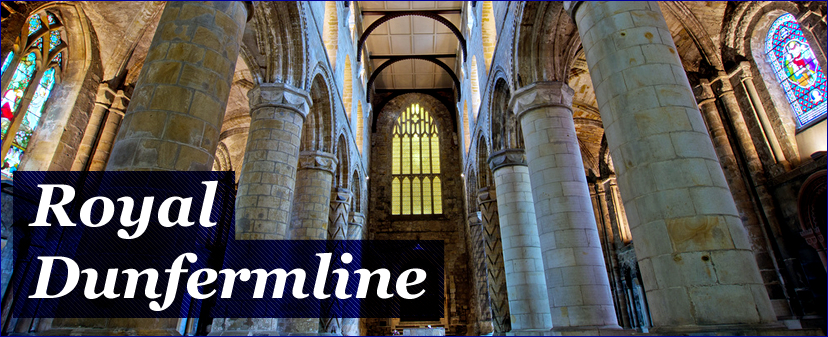
It is amazing to find that the history of Dunfermline and Dunfermline's Church seems to have been kept very quiet over the centuries. Although both played an import part in the history of Scotland from the earliest of times.
The fact that once Iona in the west was destroyed by the Vikings, and on Malcolm III making his home and the Church in Dunfermline in the east, The 'Royal Sepulture for Scotland' where he and his Queen and Saint Margaret IN 1093 along with at least twenty one of Scotland's Royals from his time, continued to be buried in this mausoleum, until the time of Robert the Bruce and when James VI had his baby son Prince Robert, Duke of Kintyre, who died 27th May 1602 buried there.
We are told that DUNFERMELITANE, was SCOTLAND'S ANCIENT CAPITAL, and that Dunfermline's history is much older than that of salted Scotland, for while we date the commencement of Scottish history from the time of Malcolm Canmore (Malcolm III) who unified the Kingdom in 1057, the city now designated Dunfermline was probably one of the principal church towns of the Picts, where no doubt the PICTISH KINGS were buried and the place revered in the same way as Icolmkill (Iona) was by the Scots in the West.
The name Dunfermline (DUNFERMELITANE) originated in Malcolm Canmore's time Dunfermellingtane meaning the foreigners` town on the hill, so called by the Gaelic-speaking population in the district to characterize the peculiar condition of affairs following Malcolm’s marriage to Margaret, the Saxon princess. On the defeat of the Queen’s brother, Edgar Atheling, by William the Conqueror, a large number of Northumbrian nobles crossed the Border and took up residence at the Scottish Court. So numerous were the strangers, it is recorded, that they outnumbered the native population, with the result that the town was called the foreigners’ town on the hill. (See “Guidi: A City of the Horestii, Appendix B. 34; The Journal Guide to Dunfermline by Mackie. Introduction by G.C. Meiklejohn B.S, C, (Arch.; F.S.P. Printed at the Journal Printing Works 1929. pp.15-16.)
Memorable Historical Events, not previously noticed, and chiefly such as have not been alluded to by other Writers on the Parish concerning the Picts, the original inhabitants of the eastern and northern parts of Scotland (so named, it is well know, from having been accustomed to paint or colour, for the sake of ornament, the exposed parts of their bodies, with the smearing of an azure herb), have left, it is thought, evidence of their existence here, in a fortification, on the summit of Craigluscar Hill, about two and a -half miles north-west from the Town. Some traces of its walls, now under the surface, still remain. (Hist. Acct. Hist. Dunf. by P. Chalmers V. 1. p.261.)
During the period of "the Roman occupation" (A.D. 83-440) our locality, like other districts, was ruled and defended by the tribes of Caledonians, Picts, Scots, &c., "who with considerable `savage address` frequently faced the Roman legions, and did havoc amongst them." For upwards of 350 years the locality on which Dunfermline now stands ever and anon "resounded to the tramp and tread of Roman cohorts and legions." (Dunf, Annals pp. 1-2))
Dr M’Gregor Chalmers tells us the first church that occupied the site upon which the Abbey now stands was a Culdee church. The colony at Iona was broken up by violence about the 7th century. At no great of time thereafter we find references to Culdee settlements along the east coasts of Scotland – Aberdeen, Brechin, Abernethy, St Andrews, Dunfermline, and so on, and it is possible that these religious settlements may have been, or, at any rate, some of them may have been established by fugitive or missionary members of the church at Iona. (Guide to Dunfermline p 72.)
All historians agree in stating that, from the fabulous times of Fergus until MacBeth, Iona was the burying place of the kings and nobles of the Scottish race. . . . There are still to be seen tombs bearing the arms of the Macdougals, Lords of Lorn, and Macleods, Mackinnons, Macquaries, and especially Macleans – that is to say, of all the chiefs of the clans of the adjacent districts, along with several tombs of bishops, priors and other ecclesiastics of the fifteenth and sixteenth centuries. ( From Controversial Issues in Scottish History by William H Gregg. N.Y. 1910 pp. 472-3.)
We know the early history of Dunfermline is uncertain being mixed with much tradition and superstition. The district would be a place of forests, swamps and moors where the wolf, deer and bear made their home. The early dwellers, painted and unclothed, lived in mud hovels, huts of turf or in holes in the ground. The coming of the Romans would be the first contact with the more civilized world. There is evidence to show the existence of a large Roman camp at Lochore and another at Carnock so doubtless the Roman legions often passed this way and may have been harried by the fierce, if unskilled guerrillas of these far off days. The early Christians of the district had a place of worship and the Culdee priests attended to the rites and practices of this primitive religion. The site of the Culdee church is thought to have been where the Abbey now stands. (Short History of Dunfermline by Jean Ritchie. p. 1.)
Dunfermline Abbey introduction - About the close of the Roman occupation of the Island of Britain (410 A.D.) and during the successive arrivals of the Teutonic tribes from the East side of the North Sea, there came hither certain pre-Columban missionaries, one of whom, by direction of Adamnan of Inchcolm, set out to visit Fife up to the Ochils. St Serf’s name is accordingly found in connection with Dysart, with Lochleven’s Isle, with Devon Valley, and beyond the hills with Logiealmond and Dunning, where he had a cave and died. He had visited Culross, and there he was buried. Somewhat later St Kentigern was connected with the same ancient town as well as with Strathclyde. So far as is known, neither of these early Christian pioneers set up any establishment on the site of our city.
The Scots - In the year 530 A.D. the Scots from Ireland landed in Cantyre and founded the kingdom of Dalriada. Thirty-three years after, they were followed by Columba and his twelve companions, who settled in Iona with the double purpose of ministering to their inflowing compatriots and instructing the Picts of the Isles and the Mainland in the elements of Christianity and the industrial arts. Successfully they pushed their way to the north and east, and were invited by a refugee Northumbrian Saxon prince to send one of their numbers to Lindisfarne when he was established in his sovereignty. Aidan went and prospered in his work.
Augustine - But in 597 A.D., the very year of Columba’s death, another and larger band sent forth from Rome by Pope Gregory, under the leadership of Augustine, landed in Kent, where they were welcomed by the King and Queen. Their converts were numerous in the land, and in due time reaching Northumbria, they came into contact with the messengers and message from Iona and triumphed. The Culdee or Columban forms of discipline, ritual and doctrine differed from those used by the Roman party. Division followed even in Iona, where a few monks fell in with the new teaching, some eighty years after Aidan had gone south to Lindisfarne. And so in this land there was from various causes a lapse from the distinctive doctrine and simplicity of life on the part of the Columban Church. During the five hundred that passed over North Britain, between the landing of Columba and the coming of the Saxon Princess Margaret to Dunfermline, there must have been many and great changes in the national, religious, and social life of the land. But her arrival marks a new and very distinctive era in Scottish history, such as led the distinguished historian, Sir Francis Palgrave, to ask – “Can any realm be found offering such paradoxes as Scotland? Results apparently so contrary to their causes; all the effects of conquest, without a conqueror; Caledonia, unsubdued by foreign enemies, yet vanquished by foreign influences; Scotland, her speech more Anglo-Saxon then English England; Scotland, more feudal then feudal Normandy; Scotland, peopled by a mixed multitude, yet in the hour of peril, united by the strongest national feeling. Scotland, the dependent of the Anglo-Norman Crown, and nevertheless protecting the Anglo-Saxon line, and transmitting that line to England.” . . . “Opposing England’s coercive dominion, she obeyed the English mind. Church and State became assimilate to the institutions of her foes and rivals.”
Malcolm Canmore derived his ancestry from a Dalriadic stem, but for fifteen years he grew up under Edward the Confessor, King of England. His predecessors had cherished their own people. For him Saxon Lothian was more attractive than Strathearn and the north and west. Dunedin was a strong fortress, yet he could not leave the Scots unwatched north of the Forth. Therefore, without quitting their bounds, he came to the southern margin of the Scoto-Pictish kingdom, and the Peel of Dunfermline became the Royal Tower, close to the Saxons of Northumbria and near means of escape, if need were to arise, from the restless Celts of the North. (Dunfermline Abbey by John Marshall p. 6.-7.)
Malcolm III. married, first, Ingebjorg, and the widow of Earl Thorfinn of Norway, she being the daughter of the Jarl Finn Arnison a descendant of Herald Harfagr. Ingebjorg's mother was a niece of St Olaf and of Harald Hardradi, King of Norway, whose wife Thora was Ingebjorg's cousin on her father's side. (Ibid.) By this marriage three sons were born, Duncan, Donald, and Malcolm. Ingebjorg died about 1067-1068. firmly that God had called her to serve Him. She held the cloisters and nunneries dear, but her court, not they, would serve her mission: that of bringing the Celts - the one people in all western Europe which still had been free into full communion with the See of Rome. Later when having won over Princess Margaret, King Malcolm Canmore III. took her for his second wife in 1070. (Ibid.) The marriage ceremony was performed by the bishop of St Andrews. St Margaret's mission in life was winning over her adopted country to the customs of the Church of Rome, supplanting the old Celtic Church. (A History of the Celtic Church by James Arthur MacClannahan Hanna. p. 59) It was in a church of the ninth or tenth century that Queen Margaret and Malcolm Canmore were married - a church small and primitive like those of Ireland in that era. They consisted of a simple oblong chamber with a single door and one small window. The walls were often built without mortar, and the wall apertures were finished with undressed stone. They might be either thatched or barrel-vaulted. "Until the Romanesque influence is felt, not a trace of any kind of ornament is to be found on these churches. Latterly a few details resembling Norman work are introduced."9 But still there were many stone buildings at the time of Malcolm Canmore and according to Boece, he did by the persuasion of Turgot, the Queen's confessor, and dedicate it to the Holy Trinity. Buchanan, too, says that he built it "at great expense; and Leslie, "magnificently" (templum, in civitate Dunfermlin - gensi magnifice suis impensis extructum, sanctiss, Trinitati diecavit.) Turgot relates, "that it was enriched with numerous ornaments, vessels of solid gold, and an inestimable crucifix, formed of gold, silver, and precious stones. But how much of the edifice Malcolm built, or of the original structure still remains, is uncertain. Additions were doubtless from time to time made to it, or portions of it replaced, particularly by Alexander I, who, according to Buchanan and Leslie, finished the abbey begun by his father, and greatly increased its revenues; as also by David I, Alexander III and James VI. (A Royal Abbey (Sermon) by Rev. James Cooper DD. p.5-6.)
Featured Downloads
The historic ancestry of andrew carnegie, additional information for the chronological table of kings, the poor of scotland & dunfermline, the ruins (poem), the journal guide to dunfermline.
- Manage Account
- The Courier ePaper
- Evening Telegraph ePaper
Hundreds greet King Charles in Dunfermline as crowds boo Nicola Sturgeon

Hundreds of Fifers turned out to see the King and the Queen Consort on their first official engagement since the mourning period for the Queen ended.
The royal pair arrived in Dunfermline – with King Charles III wearing a kilt – just after 11am to mark the granting of city status earlier this year.
They also celebrated the 950th anniversary of Dunfermline Abbey.
And hundreds of people gathered at the bottom of High Street – opposite the City Chambers – and Bridge Street to see the King and Queen Consort, with crowds in good spirit for the royal arrival.
They were welcomed by community groups, including local school children, a pipe band and Dunfermline Junior Choir.
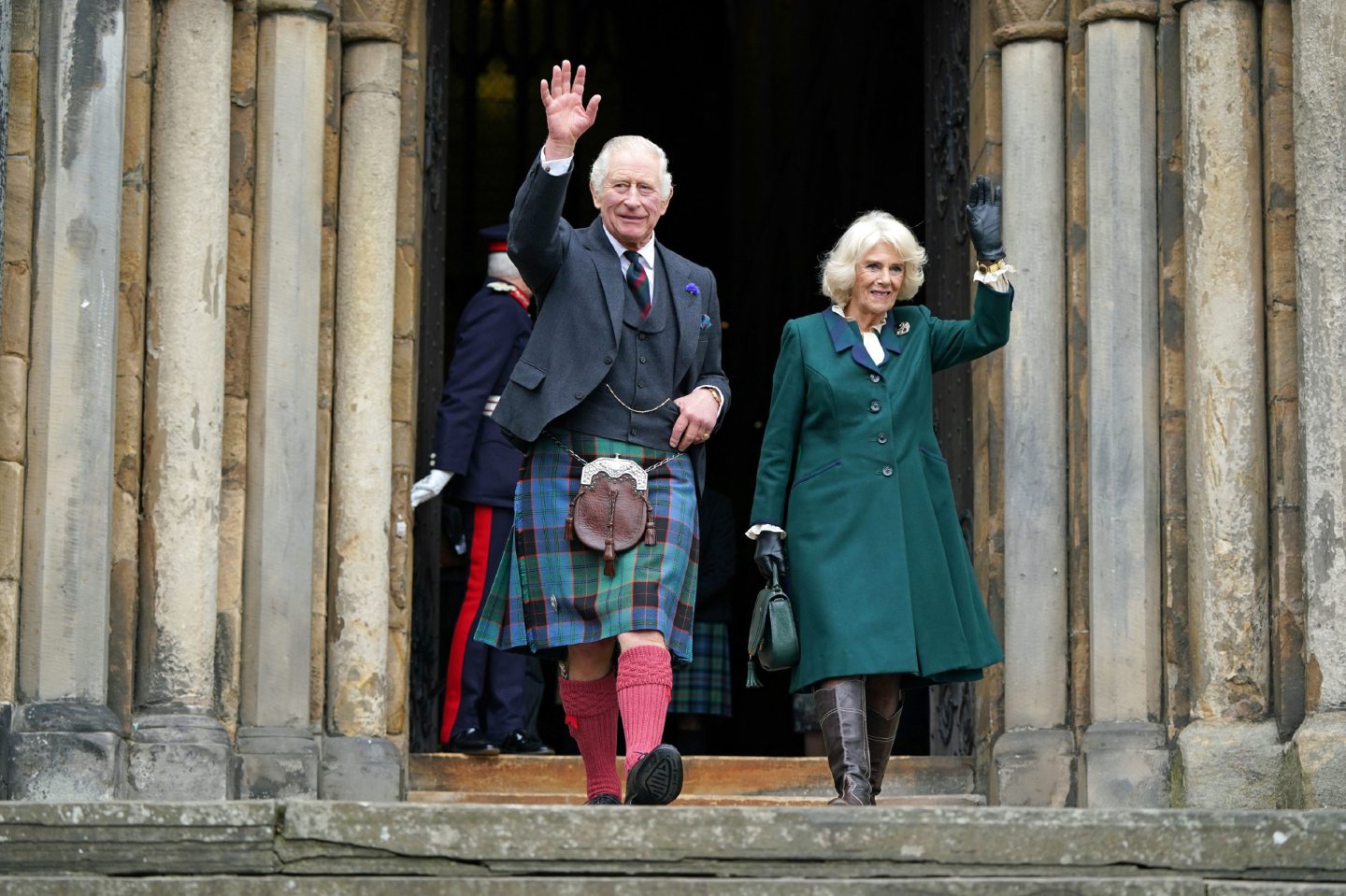
And they were joined by the Lord Lieutenant of Fife Robert Balfour, who formally introduced Scottish Secretary Alister Jack and First Minister Nicola Sturgeon.
Ms Sturgeon was booed by crowds on her arrival, although there were also a few cheers.
If you needed a reminder of how decisive Scottish politics can be, @NicolaSturgeon was mostly booed (plus some cheers) by the crowd waiting for King Charles and Camilla to arrive. This is a crowd waiting for a monarch to turn up but took me by surprise… pic.twitter.com/VknLI9W8Zp — Chris Ship (@chrisshipitv) October 3, 2022
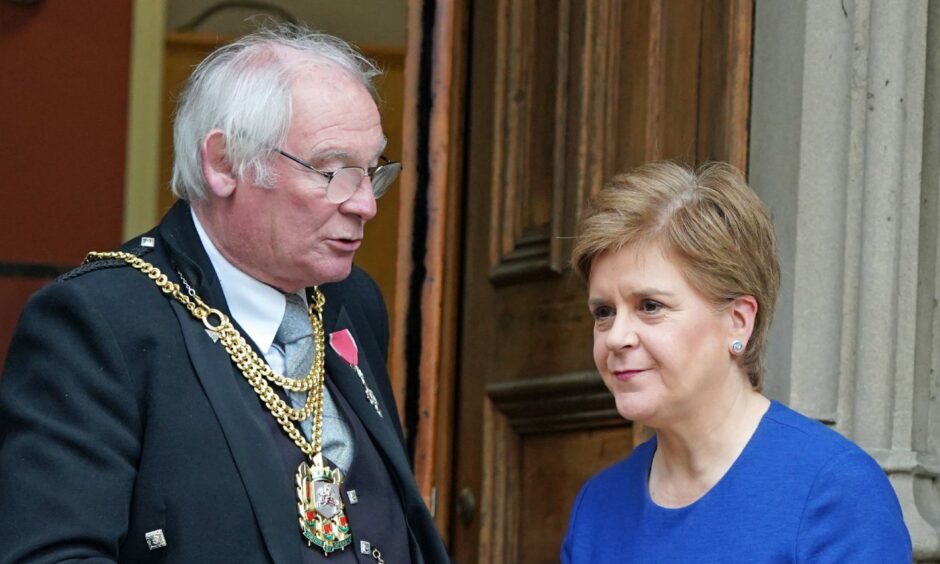
The royal couple attended an official council meeting in the City Chambers, where the King formally conferred city status and made a short speech.
He handed over the Papers Patent to confirm the new status on the former town which is now Scotland’s eighth city.
The honour was announced by the late Queen in June as part of her platinum jubilee celebrations.
Afterwards, they took a short walk to Dunfermline Abbey, burial place of King Robert the Bruce, a direct ancestor of the King.
They met with representatives from Historic Environment Scotland to learn about the history of the area and conservation of the site.
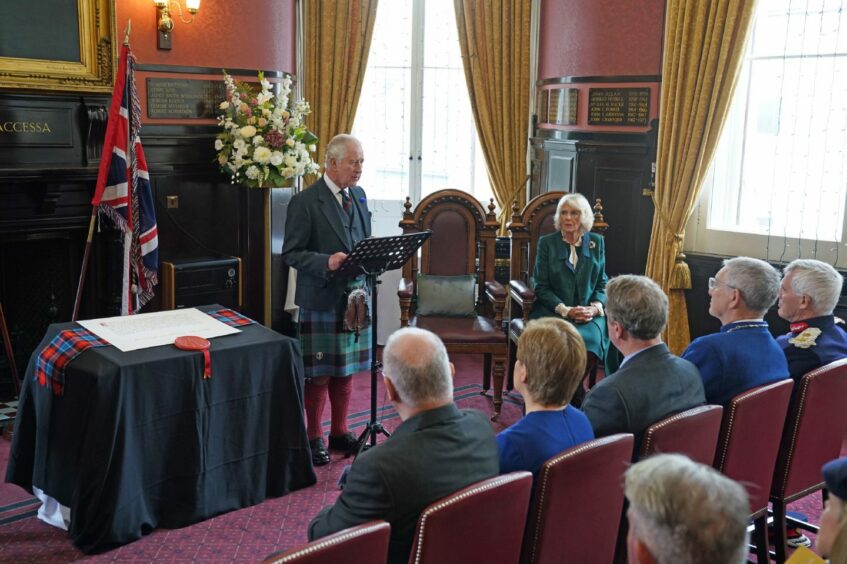
Fife Provost Jim Leishman – who welcomed the royal couple to Dunfermline – said the visit was a great honour for the city.
“It was fantastic, he said.
“It is a huge honour that the King and Queen Consort chose to come to Dunfermline on their first official visit.”
Church of Scotland Moderator Rt Rev Dr Iain Greenshields, who hails from Dunfermline, was also in attendance.
He blessed the city and said: “We are indebted to her late Majesty Queen Elizabeth for conferring, as part of her Jubilee Celebrations, city status on Dunfermline – the Auld Grey Toon.
“A Toon no longer.
“It is a privilege that this ancient capital of Scotland has been honoured in this way and it is a joy for us to gather with His Majesty King Charles to celebrate this significant moment in the history of Dunfermline.”
More from Fife
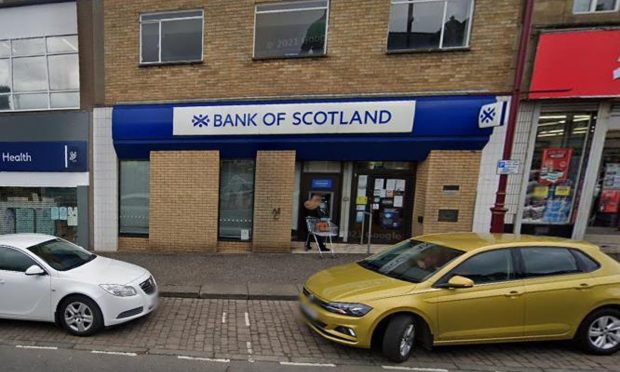
Bank of Scotland announces closures in three Fife towns

Nappy-obsessed Fife predator jailed for 'very grave' crimes
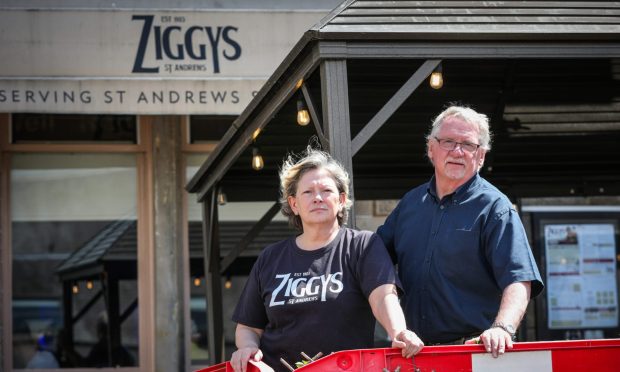
St Andrews restaurant ordered to remove outside seating in 'unfair' ruling
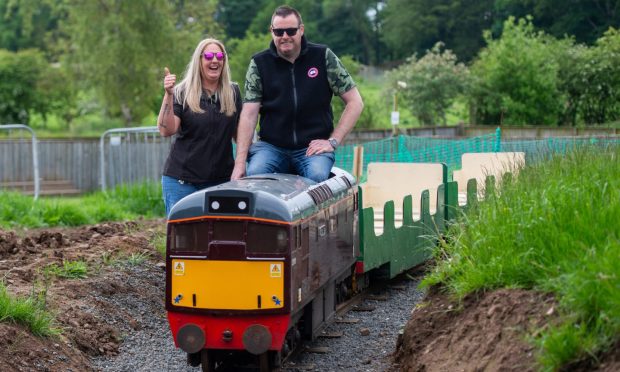
EXCLUSIVE: Fife's Scottish Deer Centre on track to unveil major new attraction
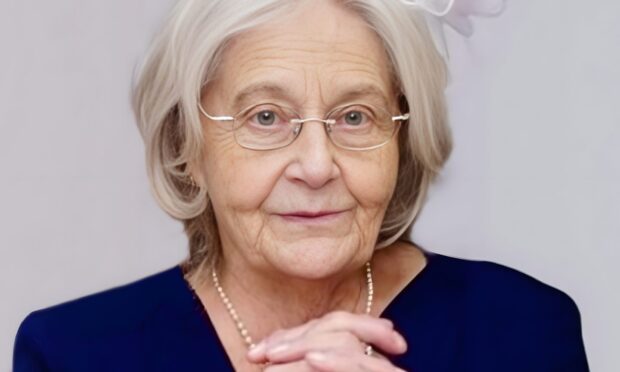
Husband’s heartbreak as NHS Fife apologises for failures before wife’s death
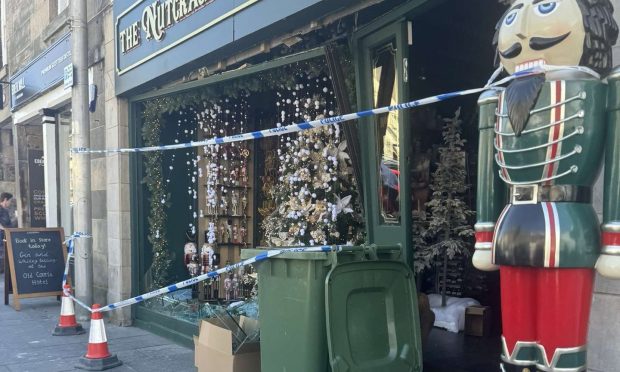
St Andrews Christmas shop damaged after 'car crashes into window'

Applause in court as Fife charity boss jailed for embezzling £40k from vulnerable residents

Man, 34, arrested after 'attack' in Glenrothes
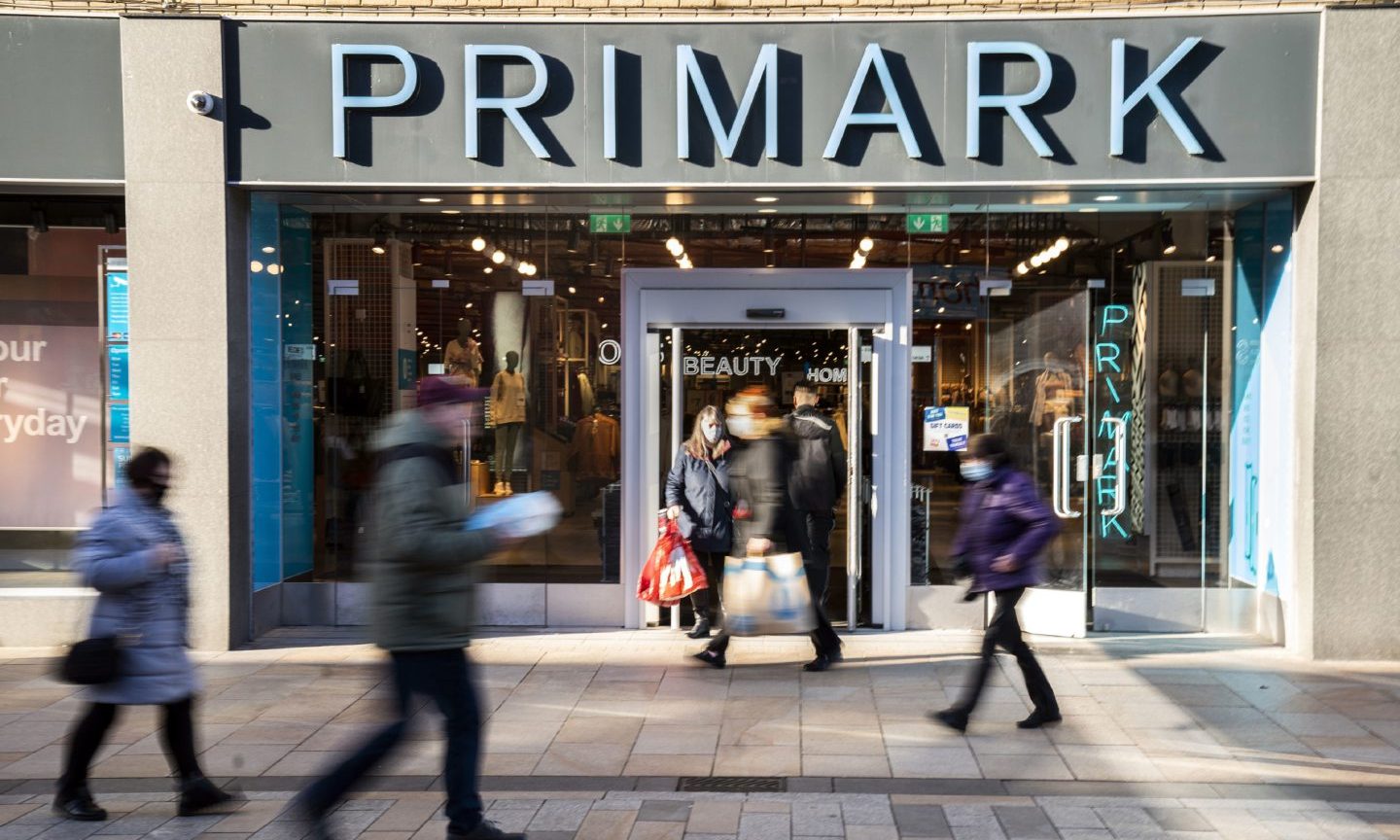
Primark quashes reports of Glenrothes Kingdom Centre opening
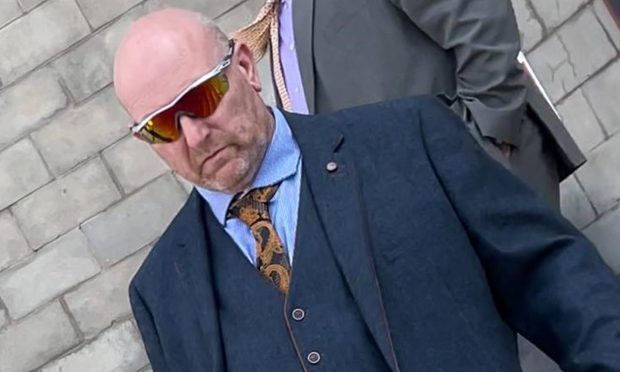
Fife businessman who assaulted heart attack survivor sentenced to unpaid work
Conversation.
Comments are currently disabled as they require cookies and it appears you've opted out of cookies on this site. To participate in the conversation, please adjust your cookie preferences in order to enable comments.
- The Minister
- Marriage Schedules
- Life Events
- HQ PAST-PORT Explorer
- Messy Church & Muddy Church Events
- The Monks’ Garden
- Youth Organisations
- Girlguiding
- What’s on at The Abbey
- Abbey Galleries
- Abbey on Film
The Lost Tomb
- The Tiffany Window
- Directions to the Abbey
- The New Abbey Church
Robert the Bruce
- Coat of Arms
- Office Bearers Since 1900
Dunfermline Abbey

Dunfermline Abbey sits at the heart of Dunfermline, Scotland’s ancient capital. Dunfermline lies thirty minutes from the centre of Edinburgh, across the spectacular Queensferry Crossing. Dunfermline`s royal and monastic past dominates a town whose lifeblood is history. Dunfermline Abbey is the final resting place of King Robert the Bruce and the post-Iona burial site of many of the Kings and Queens of Scotland.
Working in conjunction with Historic Environment Scotland, the Abbey Church of Dunfermline is now open all year round – except for intimated public holidays.
Admission is free but it is recommended that bookings should be made in advance via Historic Environment Scotland:-
https://www.historicenvironment.scot/visit-a-place/places/dunfermline-abbey-and-palace/
From Sunday 30th April, the summer opening hours will follow the same pattern as Historic Environment Scotland. Please always check either their page or our Facebook page on your day of travel as this will give clear indication of whether we are open or not.
The Abbey Church is open for Morning Worship every Sunday at 10.30am.
Last entry for visitors visiting is 4pm.
Please note that the church may be closed at short notice due to funerals, weddings and other events. Please check back here or on our Facebook Page
Friday 21st June – The Abbey Church is closed until 1pm
Saturday 22nd June – The Abbey Church is closed from 1pm – 3.15pm (approximately)
Sunday 23rd June – Morning Worship is at 10.30am. The church opens for tourism at 1pm.
Monday 24th June – The Abbey Church is closed from 11.30am – 1.30pm (approximately)
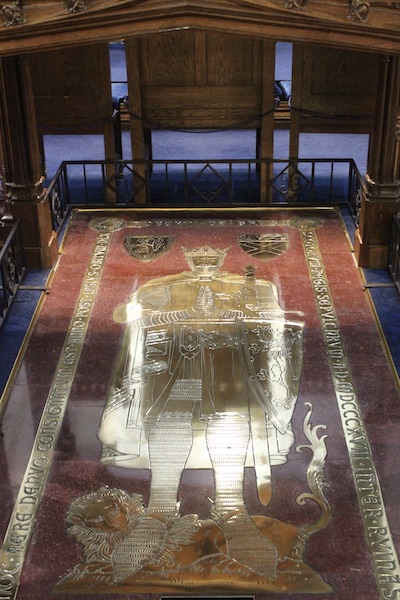
When in 1818 foundation work for the building was in progress, the tomb of King Robert the Bruce (who had been buried in the Old Abbey in 1329) was rediscovered the remains were carefully reinterred within the new Church. At this stage the design of the tower over the crossing of Nave and Transepts was completely revised by William Burn to incorporate the words “KING ROBERT THE BRUCE” around the top parapet. The tomb is marked by a full size brass gifted by the Earl of Elgin in 1889.
The Carnegie Tiffany Window

The Carnegie Tiffany Window was commissioned by Andrew Carnegie in 1913 as a memorial window for his parents. However the heritage body of the time ruled that because of its pastoral design the window was not suitable. The window was then put into storage and has been installed in a number of locations outwit the Abbey. However issues with preservation meant there was an opportunity to see if it could be installed in the Abbey, as was originally planned. The Carnegie Tiffany Window was finally installed in the Abbey in 2019, 100 years after the death of Andrew Carnegie and it is now permanently displayed in a custom made mount in the Abbey Church.
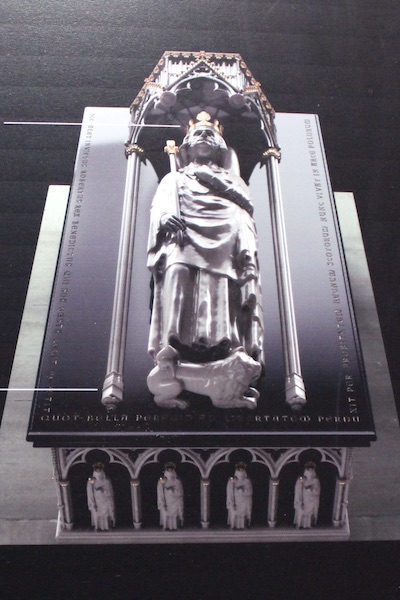
When Robert the Bruce died in 1329 he was buried in the choir of Dunfermline Abbey, and his grave marked by a tomb recorded as having been imported from Paris at the personal request of the late king. This was later destroyed probably in the Reformation era. However during the site clearance prior to the building of the present day Abbey Church fragments of carved and gilded marble, which were thought to be from the vanished tomb, were revealed.
The Lost Tomb Exhibition has a scale model reconstruction of the original tomb as well as a video with shows a 3D representation of the complete tomb placed in its original Abbey surroundings.
The Stained Glass Windows

The Abbey Church has a quite remarkable suite of large stained glass windows comprising the Sacramental Window in the East, the King Robert the Bruce Memorial Window in the North transept and the Malcolm and Margaret Window in the South transept.
Share this:
The abbey church, useful links.
- Support the Abbey
- Safeguarding
- Privacy Policy
latest News

Airborne Alliance 2024
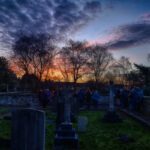
Easter Sunday 2024

Dunfermline Abbey Visitor Guide
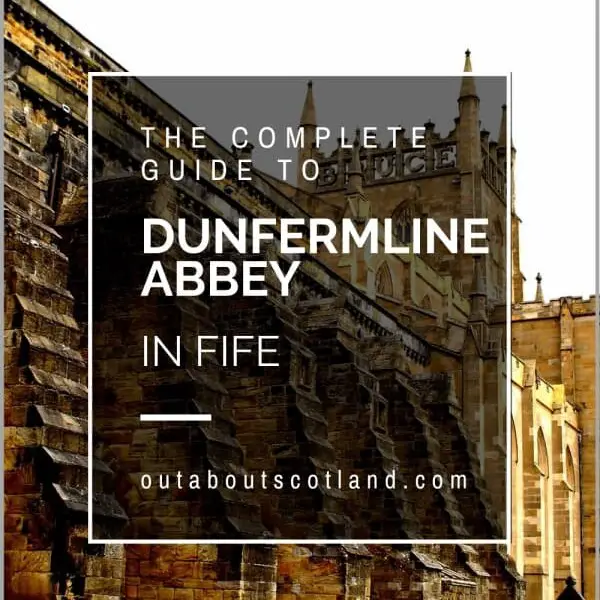
From its humble beginnings as a priory, Dunfermline Abbey in Fife rose to prominence as the final resting place of Scottish royalty, including the legendary King Robert the Bruce. Today, its imposing architecture stands as a testament to the skill and artistry of the craftsmen who dedicated their lives to its creation.
Discover the impressive stained glass windows that adorn the abbey, marvel at the intricate details of the stone carvings, and step into the hallowed halls where kings and queens were crowned in this complete guide to Dunfermline Abbey.
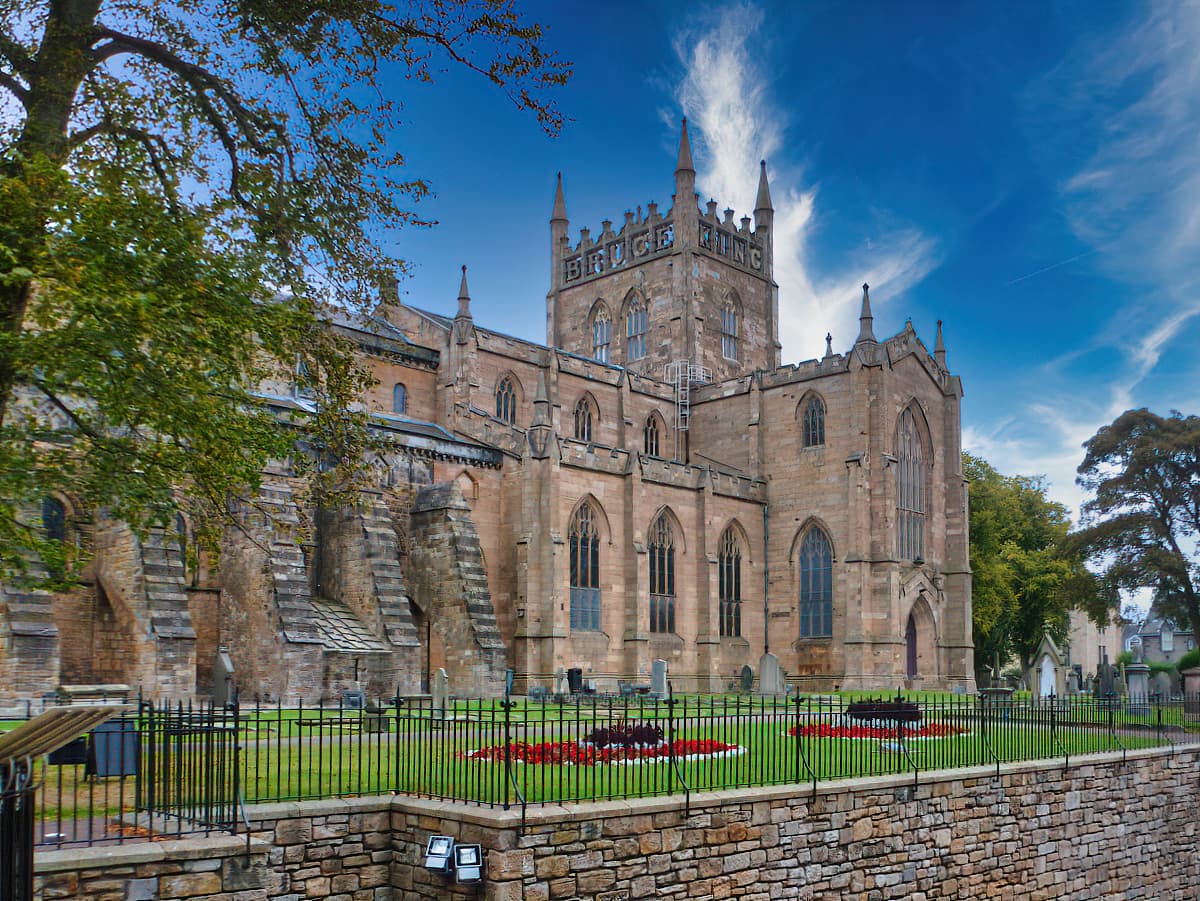
Dunfermline Abbey is a striking historical site in Fife that has foundations that date back to the 11th century and is notable for being the burial place of several Scottish monarchs, including Robert the Bruce. The Abbey and its adjacent palace ruins, maintained by Historic Environment Scotland, offer a fascinating glimpse into Scotland’s mediaeval past.
Dunfermline Abbey is a historic site that has a history stretching back almost as far as the history of Scotland itself. It’s at this 900-year-old abbey where many of Scotland’s greatest kings and queens were laid to rest, with prominent figures including Saint Margaret (wife of Malcolm III) and Robert the Bruce buried beneath the abbey grounds.
But it’s not just the inhabitants of the mausoleum that attract thousands of visitors each year, because this historic building is also renowned for its stunning architecture.
What started as a small priory in 1070 AD eventually became the grandest abbey in Scotland thanks to a continuous programme of improvements that began all the way back in the 12th century. Over the years, Dunfermline Abbey transitioned from a minor church into the magnificent structure we see today, thanks to King David I, who modelled it after the similarly impressive Durham Cathedral.
The massive Romanesque pillars inside the nave and the enormous buttresses encircling the exterior continue to astound visitors even today, and the abbey is now one of the most-visited attractions in the region.
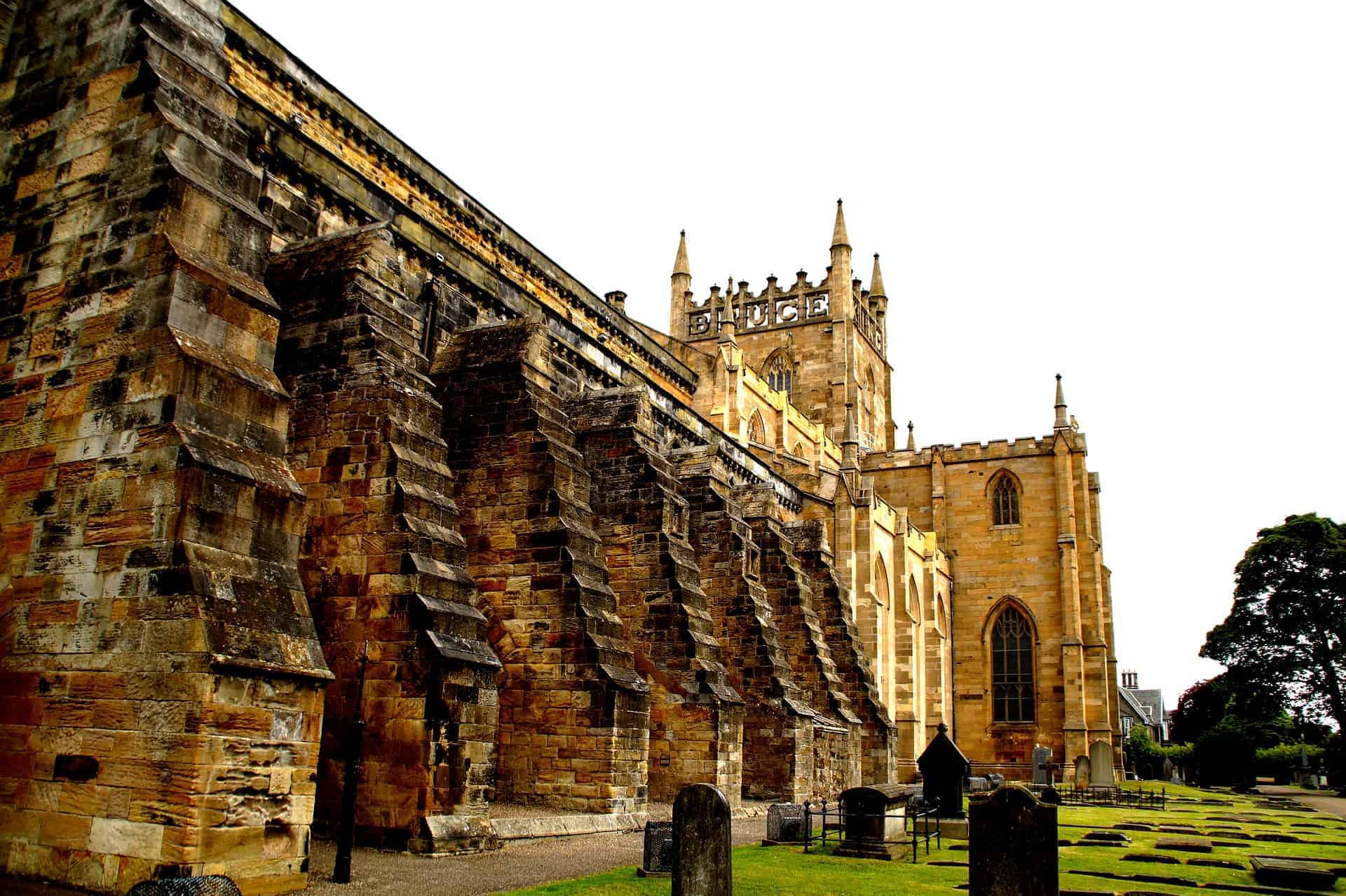
The Highlights
1: Dunfermline Abbey holds immense historical significance as the resting place of many Scottish monarchs, including Robert the Bruce. Visitors can explore the majestic royal tombs and gain insights into the lives and legacies of these influential figures.
2: The abbey’s architecture is a sight to behold. From the intricate stone carvings to the soaring Gothic arches, every corner of Dunfermline Abbey showcases the exquisite craftsmanship of its builders. One of the main highlights is the abbey’s stunning stained glass windows, which create a serene and ethereal atmosphere on a sunny day.
3: Set amidst beautifully landscaped gardens and parkland, Dunfermline Abbey offers a peaceful retreat from the bustling shops of High Street, yet it’s just a 5-minute walk from the city centre.
Visiting Tips
1: There aren’t any toilets in the cathedral, but there are lots of cafés with toilets on High Street as well as in nearby Pittencrief Park.
2: Dunfermline is a nice enough town, but after visiting the abbey, I recommend driving west on the A985 to explore the historic village of Culross instead. This attractive village is a tourist attraction in its own right and takes just 15 minutes to reach by car.
3: If you’d rather stretch your legs in Dunfermline you’ll find Pittencrieff Park nearby, which features a pavillion, a play park, landscaped gardens, and a cafe.
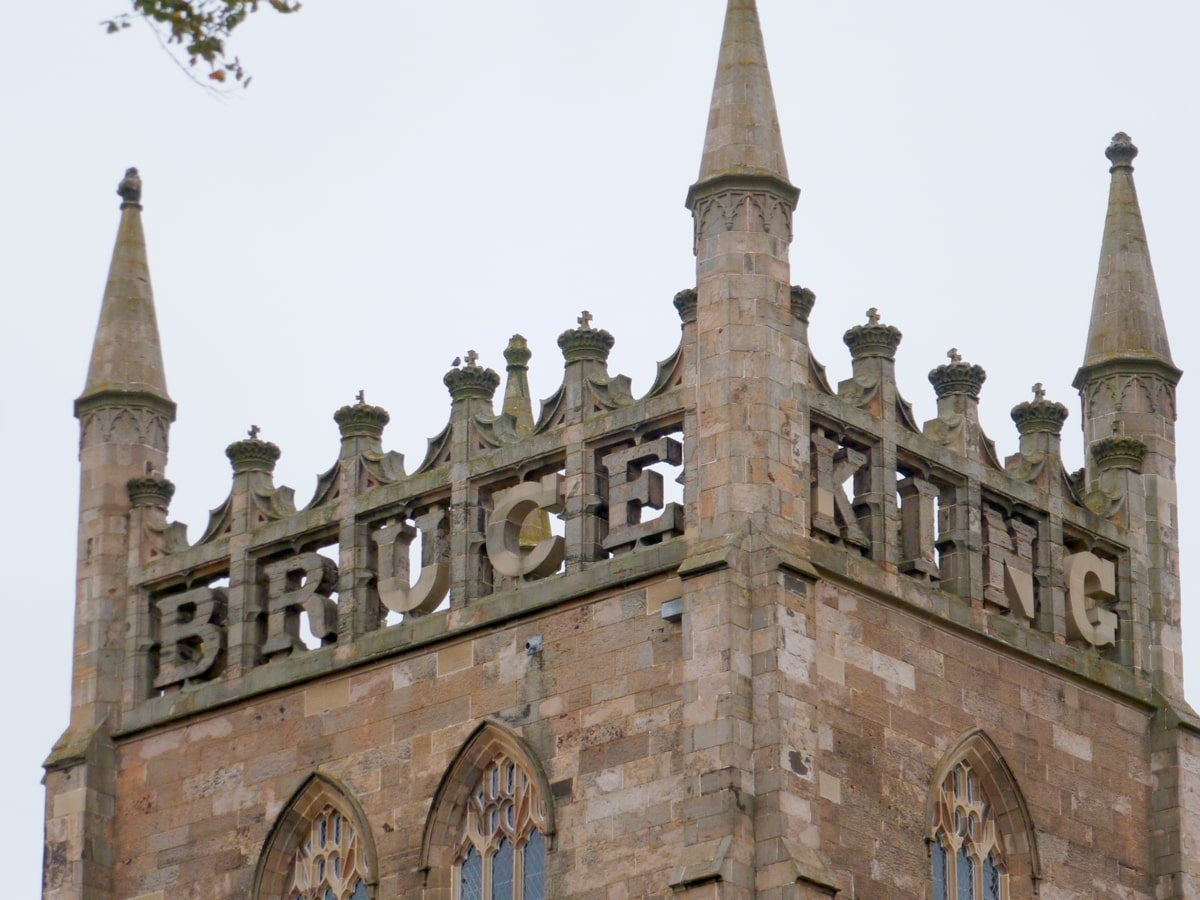
Tourist Information
The grounds surrounding the abbey are enormous and are home to a vast collection of tombs and gravestones, making them the best place to begin a tour of the site. After wandering around the graveyard, I recommend entering the nave to look up and gaze at the pillars and columns that tower overhead.
It’s amazing how mediaeval stonemasons managed to create such monumental buildings back in the day, especially Dunfermline Abbey, which still manages to impress visitors 900 years after its foundation stones were first laid.
More than 30,000 tourists visit this historical site each year, most of whom make a point of seeing the bronze floor plaque marking the location of Robert the Bruce as well as the elaborate shrine of St. Margaret which is located at the east end of the nave. Leaving the nave, you can head towards the gatehouse where you’ll see the ruins of the old monk’s refectory, while the nearby 76-acre Pittencrieff Park can be easily visited through a gate at the western end of the cathedral.
The park is well worth taking the time to visit as it has several attractions including a museum, a pavilion, and a peacock sanctuary. Entry to the park is free and the park is open year-round.
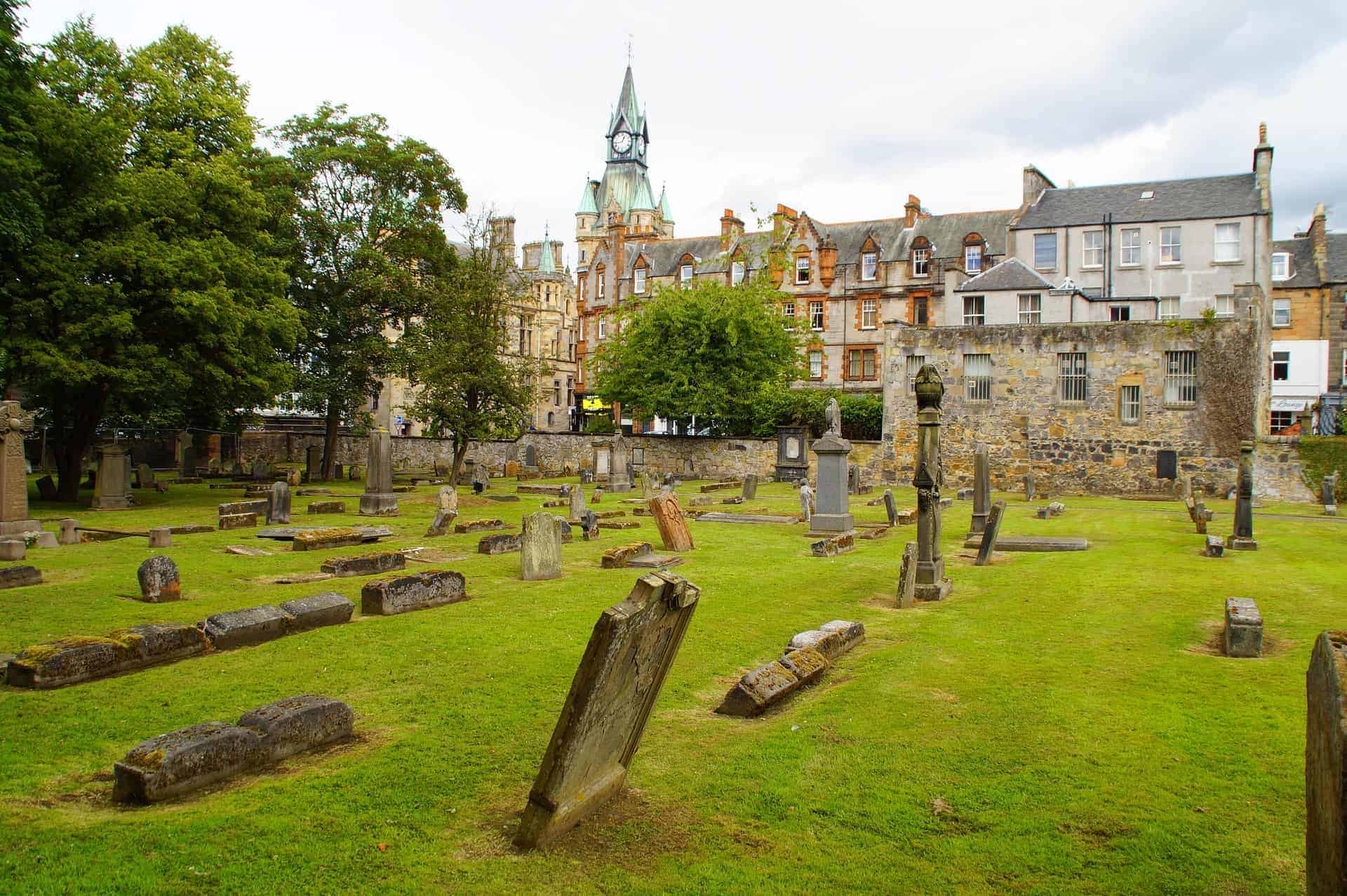
The priory that Malcolm III founded in the 12th century served as Dunfermline’s first place of worship, and it’s on top of this modest church that the present-day Dunfermline Abbey was built. It was actually Malcolm’s wife, Margaret, who introduced Benedictine monks to Dunfermline Priory, and after her death, her son, David I, began work to build a magnificent abbey that would rival any other in Scotland.
In 1250, the remains of Margaret (later to become Saint Margaret) were moved to a shrine at the eastern end of the abbey, which led to Dunfermline becoming the primary site for royal burials in later years.
Perhaps even more famous than Saint Margaret’s tomb is that of Robert the Bruce, who was interred there in 1329. King Robert had close ties to the abbey as he had personally overseen its reconstruction after it was damaged by Edward I during the Scottish Wars of Independence.
Unfortunately, the abbey was ransacked and almost destroyed during the Scottish Reformation in 1560, but thankfully, the nave was left unharmed. Although Dunfermline Abbey lost its status as a site of royal burials shortly after the Reformation (Iona Abbey was used instead), the nave continued to be used as a parish church right up to the present day.
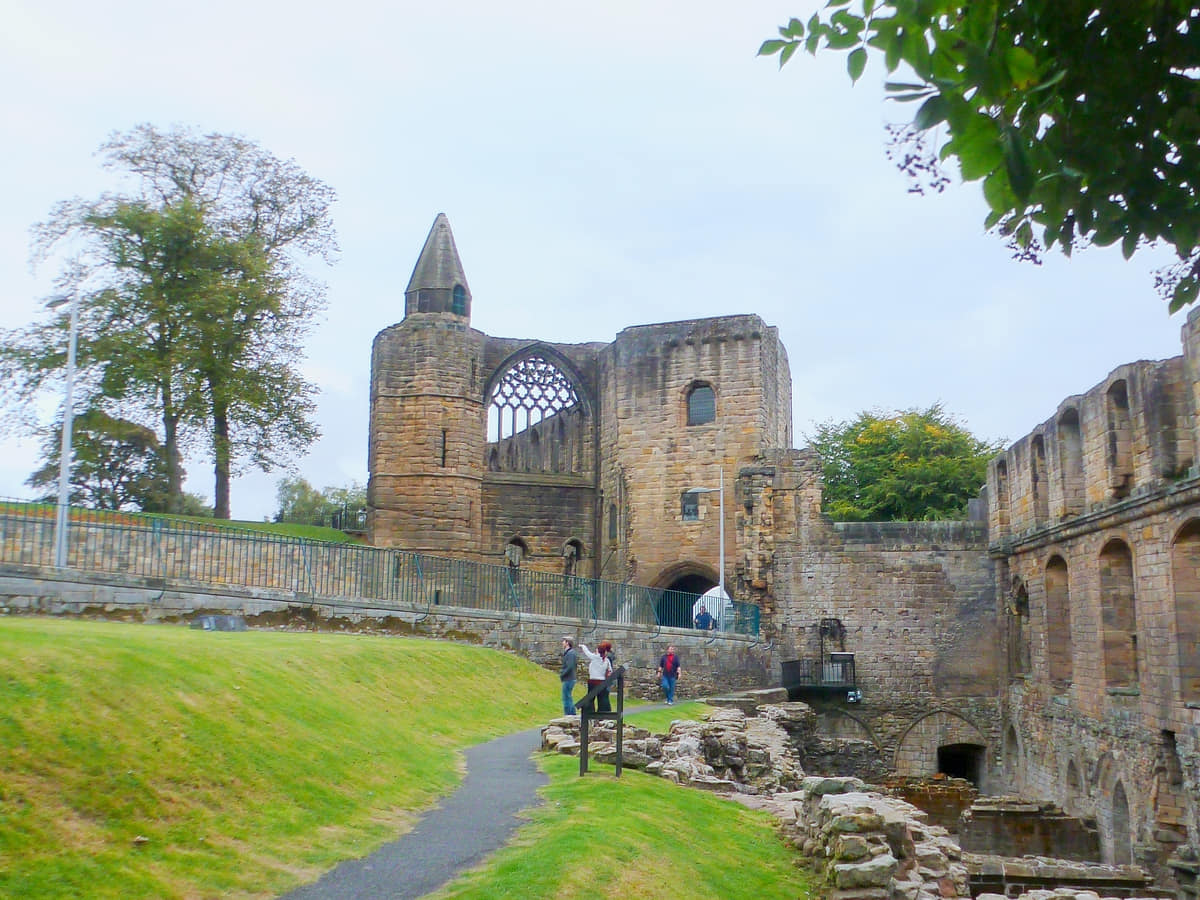
Things to Do
Visit the Abbey : The Abbey is an architectural marvel with parts dating back to the 12th century. Home to the tomb of Robert the Bruce, Scotland’s famous king, it’s a must-visit for anyone with an interest in history.
Explore the Abbey Nave. The Abbey Nave is a beautiful example of Romanesque architecture. Marvel at the detailed stone carvings, the towering pillars, and the beautiful stained glass windows. The Nave is also home to a collection of mediaeval grave slabs and historical artefacts.
Explore Dunfermline Palace : Discover the rich history of Scotland by exploring Dunfermline Palace, a former royal residence that’s part of the Dunfermline Abbey complex. Walk through the ruined halls and rooms and learn about the lives of the nobility that once called it home.
Walk through the Historic Grounds : The area surrounding Dunfermline Abbey is filled with beautiful gardens and parks. Pittencrieff Park is well worth a visit, as it features lots of footpaths, greenhouses, a pavilion, a cafe, and a children’s play park.
Visit the Church : The parish church is part of the abbey complex and is open to visitors to explore as part of a self-guided tour, though visitors should note that it’s still an active place of worship so access might not be possible on certain days.
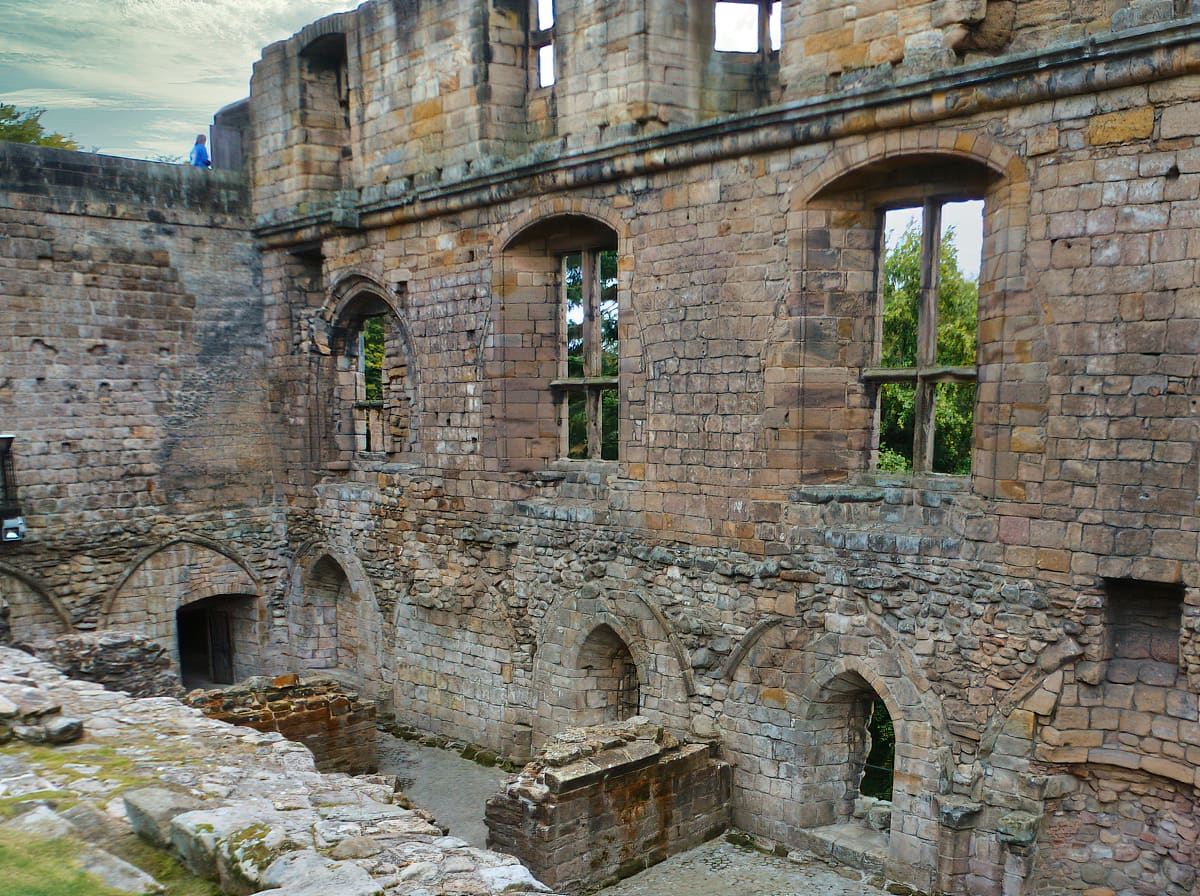
Things to Do Nearby
Pittencrieff Park . Pittencrieff St., Dunfermline, KY12 8QH. 1-minute walk. An extensive public park with a spiderweb of footpaths through managed lawns and coppices. The park includes children’s play areas, a pavilion, several memorials, a peacock sanctuary, and more.
Dunfermline . 2-minute walk. Historic Dunfermline offers several local shops, cafés, pubs, and restaurants on its high street, which is an easily accessible walk from the abbey.
Andrew Carnegie Birthplace Museum . Moodie St., Dunfermline, KY12 7PL, is a 4-minute walk. A museum is dedicated to the entrepreneur Andrew Carnegie, who was born in Dunfermline but later moved to America to become the world’s richest man. The museum features original artefacts as well as displays of 19th-century life in Dunfermline.
Abbot House, 11 Maygate, Dunfermline, KY12 7NE, is a 2-minute walk. A local centre for Dunfermline history and heritage. This historic building aims to preserve the story of the town and its people with a collection of archives, exhibits, and displays. There is a café and a microbrewery on-site.
Pittencrieff Glasshouse, Dunfermline, KY12 8QH, is a 2-minute walk. A large, refurbished glasshouse that is over 200 feet long. The glasshouse contains a variety of exotic plant species from across the globe. The front of the glasshouse features ornamental gardens and flower borders.
Frequently Asked Questions
Is dunfermline abbey worth visiting.
Dunfermline Abbey is definitely worth visiting, especially if you have an interest in history and architecture. Located in Dunfermline, Fife, the abbey contains more than 900 years of history and is considered one of the most historically significant sites in Scotland.
The abbey is renowned for its beautiful stained-glass windows and the grounds of the abbey are equally remarkable, featuring beautiful gardens and a historic graveyard that’s the final resting place for many Scottish nobles.
What is Dunfermline Abbey famous for?
Dunfermline Abbey in Fife is famous for being the grave site of several of Scotland’s kings and queens, including Robert the Bruce, St. Margaret, David I, and Robert I. Dunfermline Abbey has more royal graves than anywhere else in Scotland, except for Iona Abbey.
Is Dunfermline Abbey free?
The abbey and nave are open to visitors free of charge. Visit the Historic Environment Scotland website for the current opening times.
When was Dunfermline Abbey destroyed?
During the Wars of Independence in AD 1303, English troops partially destroyed Dunfermline Abbey. Protestants also sacked it in 1560, after which it fell into ruin.
Related Posts
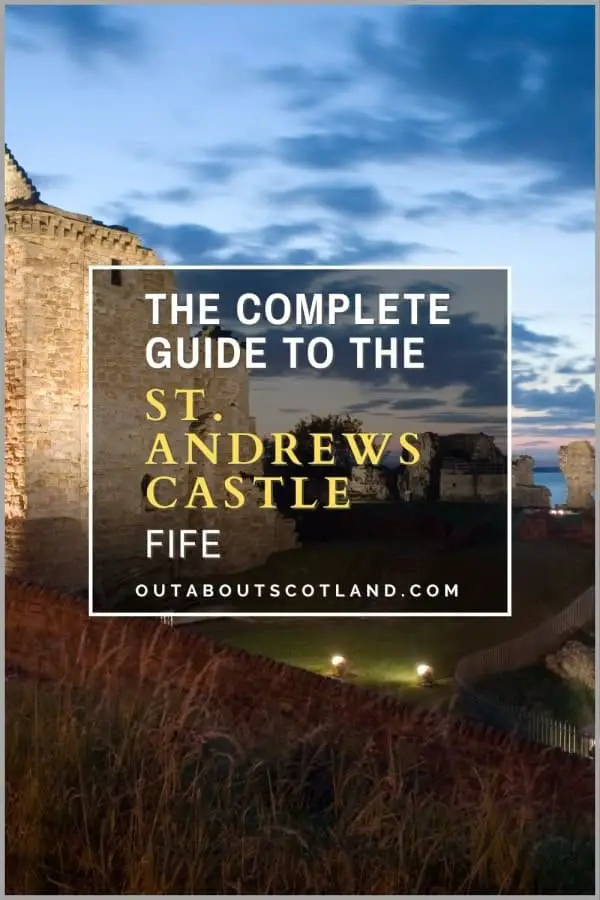
St. Andrews Castle Visitor Guide

The Best Things to Do in Fife for Families

Tentsmuir Nature Reserve Visitor Guide

East Neuk of Fife Visitor Guide
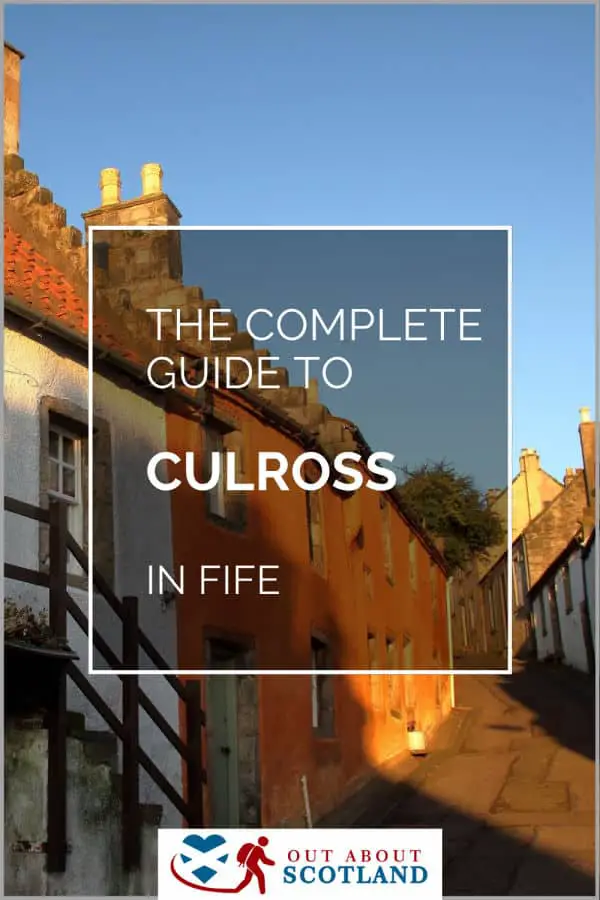
Culross Visitor Guide
Craig Neil is the author, photographer, admin, and pretty much everything else behind Out About Scotland. He lives near Edinburgh and spends his free time exploring Scotland and writing about his experiences. Follow him on Pinterest , Facebook , and YouTube .
We've refreshed our website design so things may look a little different if you've been here before. We'll be making more improvements soon so watch this space.
Top 7 Things to Do in Dunfermline
Granted city status in 2022, there are lots of cool things to do in Dunfermline to shout about. From discovering its royal connections and delicious food and drink scene to embracing its live music culture, make yourself feel at home in this historic city.
Andrew Carnegie Birthplace Museum Dunfermline
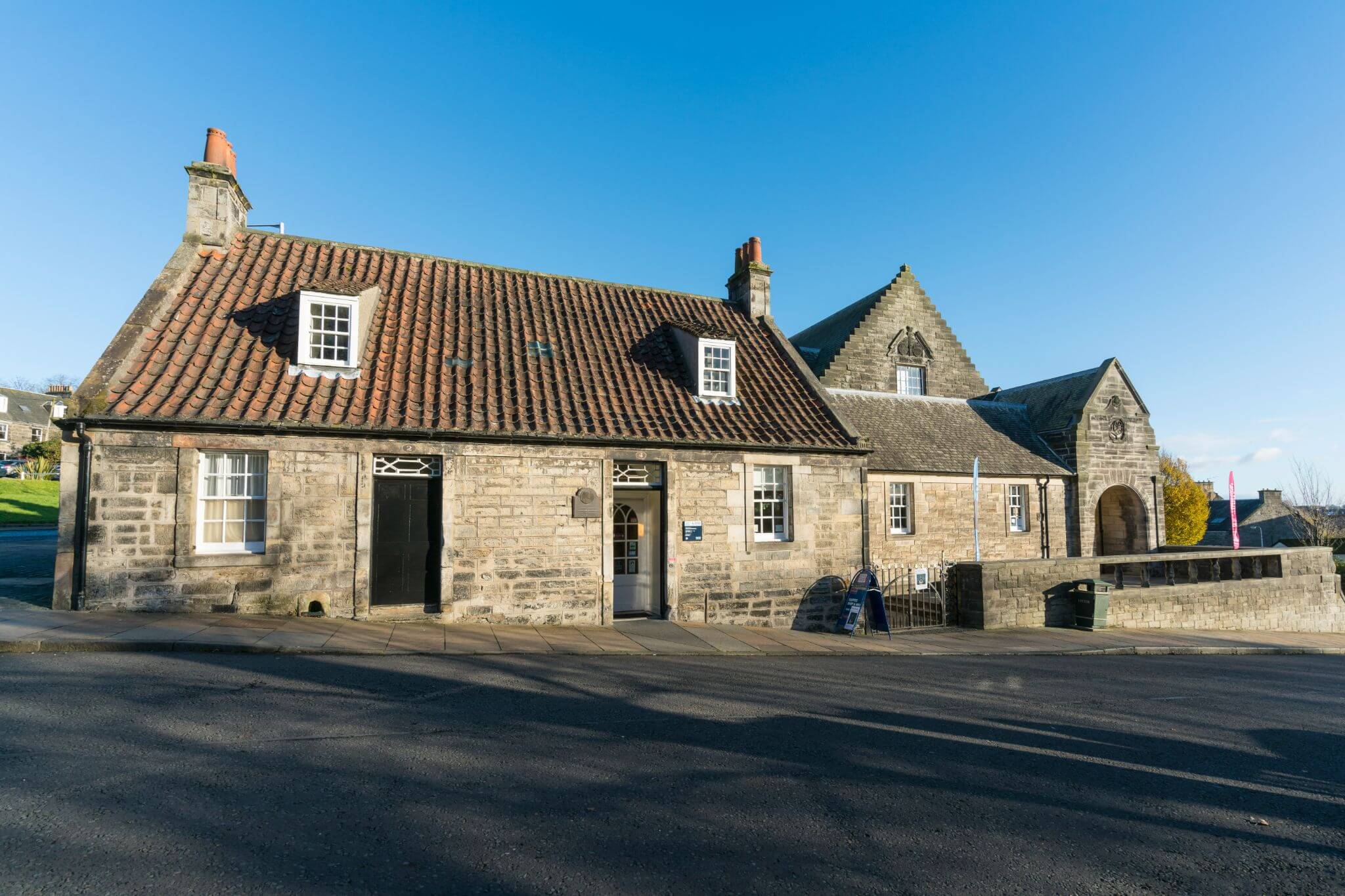
The Andrew Carnegie Birthplace Museum, Dunfermline
© VisitScotland / Kenny Lam
Andrew Carnegie is a well-known celebrity here in Dunfermline. Born and bred in the city, the philanthropist made a name for himself when he emigrated to the US and led the expansion of the American steel industry in the late 19th century. When he retired, he was one of the richest men in America and used large amounts of his money to fund charities. Visit the humble cottage where it all began and discover Carnegie’s surprising links between other famous individuals including Marie Curie, Theodore Roosevelt and even the Diplodocus carnegii dinosaur.
- On Public Transport Route
- Hearing Loop
- Accessible Parking Or Drop-off Point
- Level Access
- Accessible toilets
Dunfermline Abbey and Palace Dunfermline
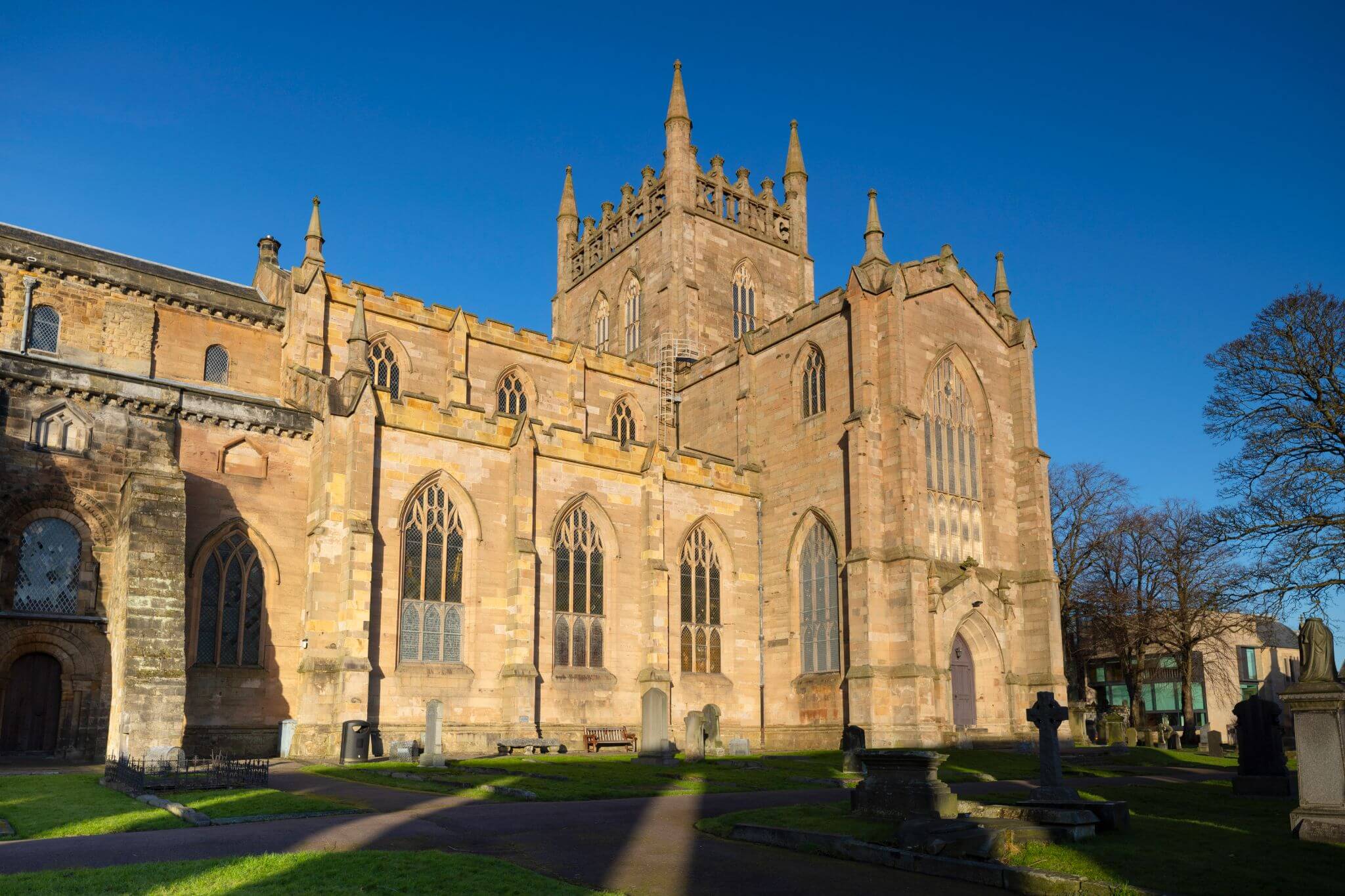
Dunfermline Abbey
Founded as a priory by Queen Margaret in the 11th century, Dunfermline was made an abbey by David I and later became a final resting place for many of Scotland’s monarchs, including King Robert the Bruce. During your visit here, marvel at the Romanesque architecture and search for the fossilised crustaceans in the marble plinth of St Margaret’s shrine. Make sure to check out the impressive nave where you’ll see portraits of Queen Margaret, Malcolm Canmore, William Wallace & Robert the Bruce.

Jack 'O' Bryan's Dunfermline City
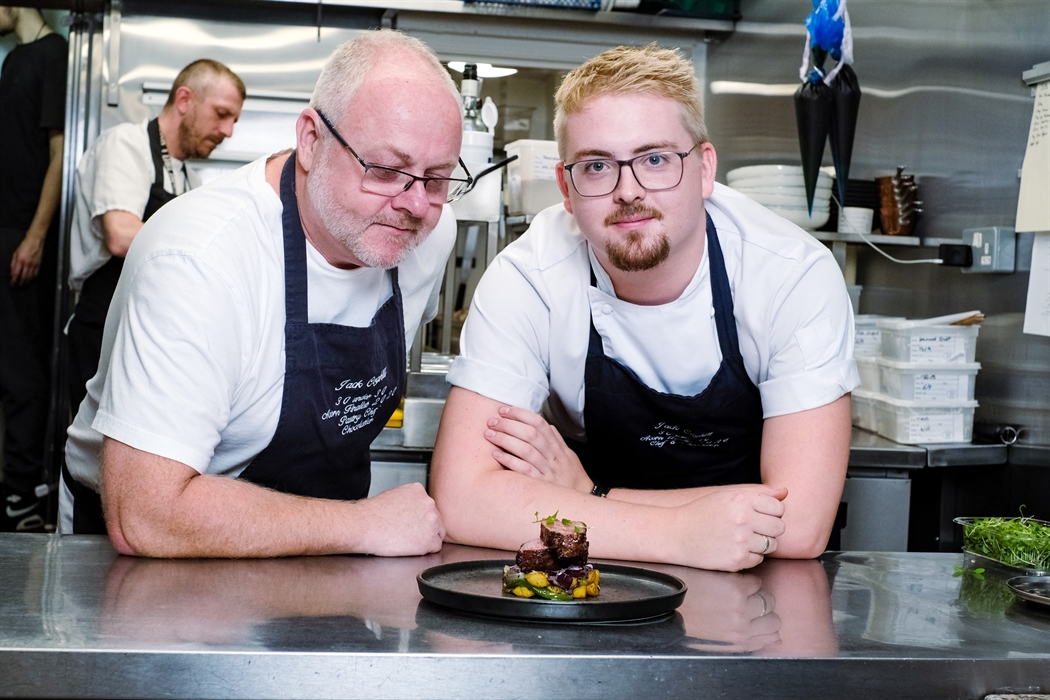
Jack O'Bryan's Bar & Kitchen
If you’re looking to refuel your energy levels, be sure to check out Jack ‘O’ Bryan’s. Tucked away beside Pittencrieff Park, this kitchen and bar restaurant offers traditional Scottish dishes with flavours inspired from across the world. Highlights on the menu include Singapore mussels, rack of lamb and langoustines, with veggie options such as barbecued aubergine gratin and cauliflower and pesto. Room for dessert? Sweeten the deal with sticky toffee pudding or burnt basque cheesecake.
Pittencrieff Park Dunfermline
Pittencrieff Park
© Welcome to Fife / Luigi Di Pasquale
Known to the locals as “The Glen”, Pittencrieff Park was gifted to the people of Dunfermline by Andrew Carnegie in 1902. Since then, it has become a popular hotspot for tourists and locals alike, offering woodland walks and a children’s play area. The Glen Pavilion also sits within the park. The impressive Art Deco style building has held many events, conferences and weddings throughout the years and has welcomed guests including Her Majesty The Queen and His Holiness The Dalai Lama. If you’re looking to delve into Dunfermline’s historic past, head to the eastern side of the park where you’ll find Dunfermline Abbey and Palace.
- Pets Welcome
Abbot House Dunfermline
The unicorn beside the Abbot House in Dunfermline
Looking pretty in pink is Abbot House. This beautiful ‘A’ grade-listed building is situated within Dunfermline’s Heritage Quarter, just a short distance from Dunfermline Abbey and the Dunfermline Carnegie Library & Galleries. The house has had its fair share of tumultuous times, from surviving The Great Fire of Dunfermline in 1624, to national and international wars and religious unrest. Thankfully, all is now calm when you visit today! Shop for beautiful artisan gifts or get your caffeine fix at their very own coffee shop. On a nice day, take a leisurely stroll through the Walled Garden, where you’ll be treated to stunning views across the graveyard to Dunfermline Abbey.
Clan Mackenzie Routes – Walking Tours Dunfermline
Dunfermline Abbey seen from Carnegie Library and Galleries
There is nothing better than exploring a new city with a local expert. Clan Mackenzie Routes specialise in walking tours for all those who love history. Choose from two of the tours on offer. Visit fantastic historic attractions including Abbot House and Dunfermline Abbey on the 90-minute Royal Heritage and History Tour, or take a whistle stop tour of the life and legacy of Dunfermline’s very own Andrew Carnegie.
Alhambra Theatre Dunfermline
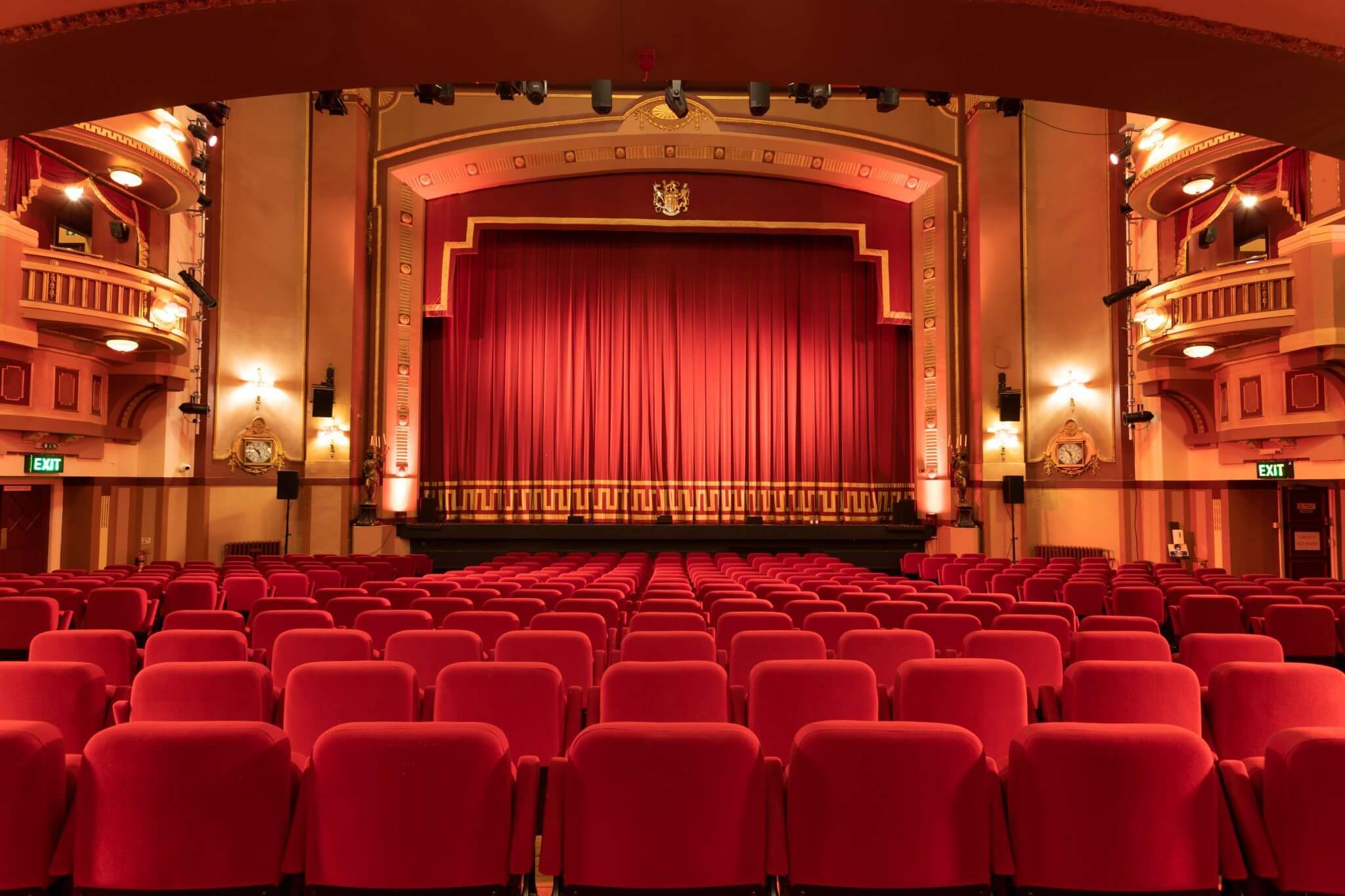
The central stalls at Alhambra Theatre
© Alhambra Theatre
Before we draw the curtain on our top things to do in Dunfermline, we’re here to shine a spotlight on Alhambra Theatre. Pick the best seat in the house and enjoy a variety of shows from music concerts, comedy, dance, musical theatre and pantomime shows. With ample leg room in the stalls and comfortable seating, you’ll be able to sit back, relax and enjoy the show.
Find experiences
JavaScript needs to be enabled to see this product search form. You can turn this on in your browser settings.
Other things you might like

Dunfermline
Scotland's 8 cities
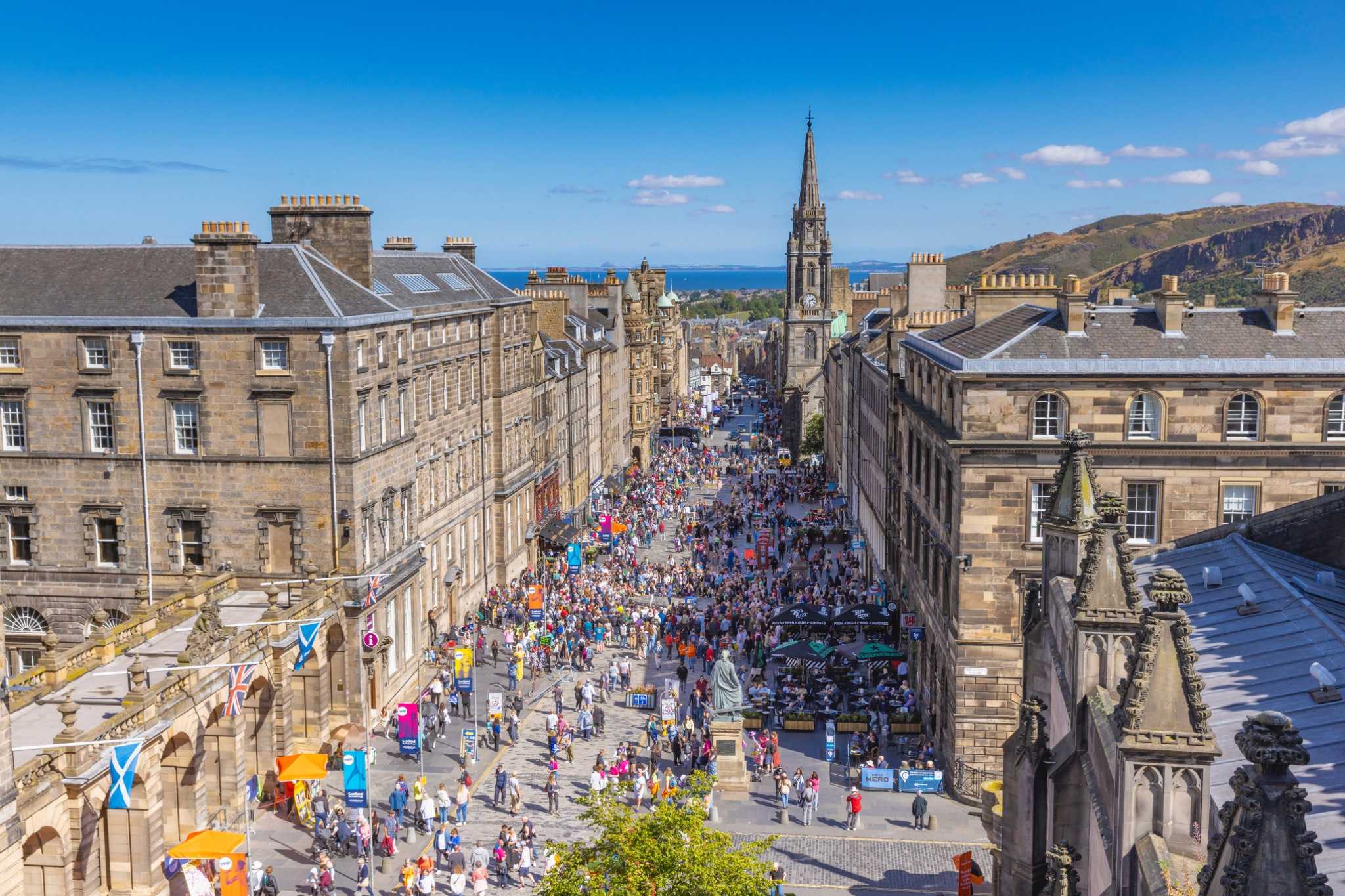
Edinburgh & The Lothians

- > A Royal Resting Place – Dunfermline Abbey
A Royal Resting Place – Dunfermline Abbey
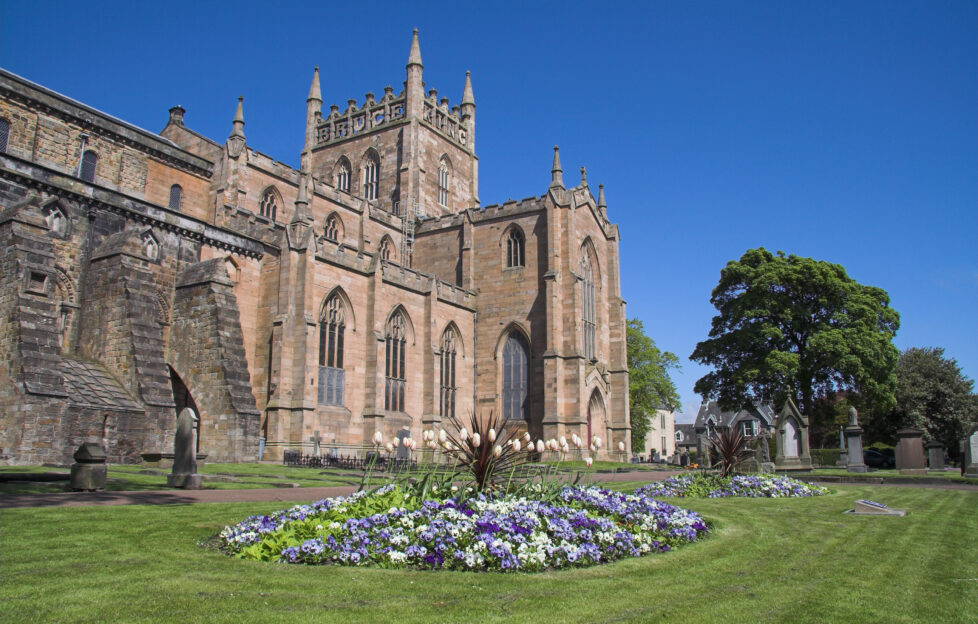
Dunfermline Abbey is of breathtaking historical significance…
This magnificent building is an attraction on two counts. Firstly, for its superb architecture and secondly as the resting place of some of Scotland’s greatest kings and queens.
This double role makes it one of the country’s most important cultural sites and a must-see for anyone visiting south-west Fife.
It is one of the foremost Scottish religious sites after Iona Abbey, and has been a place of worship since 1072, continuing as a working church today.
The western half, now ruined and under the care of Historic Environment Scotland (HES), was commissioned by David I on the site of a smaller church. This was established around 1040 by his mother, Queen Margaret, later to become St Margaret.
His church extended further east under what is now the Church of Scotland. The eastern half, sitting on the remains of the choir of the old abbey, is a parish church. During the early part of its construction in the 19th century, however, workmen made a sensational discovery.
The skeleton of Robert The Bruce was found in a vault wrapped in a shroud. It was re-buried below the pulpit of the new church, and the 200th anniversary of the reinternment of Bruce’s remains was marked in 2019.
“Dunfermline is hugely important in the national story as a royal burial place,” says Judith Anderson, of the Cultural Resource Team at HES. “The tombs, which lie under the present-day abbey church, include those of figures who truly shaped Scotland such as St Margaret, her husband Malcolm Canmore, David I and Robert The Bruce.
“It was not unusual for important people to be exhumed and reburied so that their resting place was appropriate to their status. We think St Margaret’s remains were interred several times in different locations.
“A special chapel was built for her in 1250, but only the foundations survive. This shrine is outside the walls of the present-day abbey, at the far east end.
“The abbey’s great nave dates back to the 12th century and is the only part of David’s original church. The interior would have been much more colourful with painted scenes on the walls. A few fragments of these still survive.”
Each year, between 30,000 and 35,000 visitors come to the abbey to visit the tomb of Bruce, marked by brass gifted by the Earl of Elgin in 1889. But the warrior king was given a more fitting epitaph, with the words “King Robert The Bruce” incorporated around the top parapet of the Abbey’s tower.
The ruins looked after by HES have their own significant place in history. The site isn’t just that of King David’s church but also a great complex of monastic buildings and living quarters. It also included a royal palace where Charles I was born, the last monarch to be born in Scotland.
Whether you visit for religious reasons or for a cultural or historic crusade, the present-day abbey and the historic ruins alike will make a lasting impression.

Subscribe to The Scots Magazine for more about Scotland >>
Related posts.
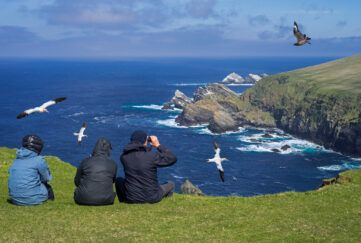
Did You Know? Shetland!
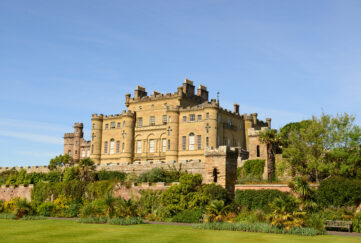
Did You Know? Ayrshire!
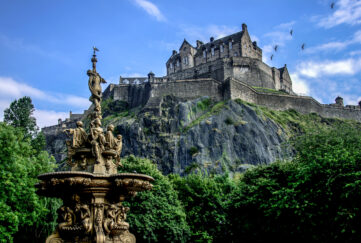
Did You Know? Edinburgh!

Find a Stockist
Enter your postcode below (with a space) and click "Find" to search for your local stockist.
Select a ticket option
- Standard Admission, Member & Explorer Pass Tickets
- Partner Organisation Tickets
- Save with an Explorer Pass
- Buy Membership
Dunfermline Abbey and Palace
St Margaret’s Street, Dunfermline, Fife, KY12 7PE
- 01383 739 026
Dunfermline Abbey has a special place in the nation’s heart. Laid to rest here are some of Scotland’s great kings and queens – including Robert the Bruce. The abbey’s great nave is also the most visually stunning example of Romanesque architecture in Scotland.
Dunfermline’s story stretches back to the 11th century – the time of Malcolm III and his queen, Margaret. Their son, David I, raised the status of the little priory to abbey in the 12th century. He endowed it richly, and brought stonemasons from Durham Cathedral to build it.
The abbey church is famous as the mausoleum of:
- Margaret (later canonised as St Margaret)
Late on in its history, the abbey guesthouse range became a royal palace, along with some additional buildings. The ill-fated Charles I was born here in 1600.
From priory to abbey
In 1070, Margaret founded a priory in Dunfermline on the site where she had married Malcolm III. She introduced a small community of Benedictine monks from Canterbury, and so laid the foundations of the first Benedictine house in Scotland.
David I made the priory an abbey in 1128. He had a new church built on a grand scale, of which the magnificent nave survives. The Romanesque pillars are similar to those of Durham Cathedral, and it’s likely that the same masons carved them.
In 1250, St Margaret’s remains were moved to an elaborate shrine at the east end of the church. A 19th-century parish church (Abbey Church) now stands on the site of the choir and presbytery. This is the location of the tomb of Robert I and the other royals buried here. It is home to an active Church of Scotland congregation.
For opening times of the Abbey Church (not in the care of HES) please visit dunfermlineabbey.co.uk .
The Bruce at Dunfermline
After Edward I badly damaged Dunfermline Abbey in 1303, Robert I financed its rebuilding. It was a move that showed confidence in the affluence and self-reliance of his kingdom following the Wars of Independence with England.
The most impressive of the new buildings was the monks’ refectory, a soaring structure with an elaborate façade, which took full advantage of the sloping site.
Robert I was interred before the high altar in 1329. His heart was taken on crusade before eventually being buried at Melrose Abbey .
The Reformed Church at Dunfermline
After the Protestant Reformation in 1560, the:
- nave was converted into a parish kirk for the people of Dunfermline
- old choir was allowed to collapse
The state assumed responsibility for the care of the nave after the new parish church was built on the site of the choir between 1818 and 1821.
Dunfermline Palace
Medieval abbeys typically had several grades of accommodation, and it’s likely that the guesthouse was a royal residence right from the start.
After the Reformation, a new palace was created out of the guesthouse and the west range of the abbey. Dunfermline Palace became the personal residence of James VI’s queen, Anna of Denmark.
The future Charles I was born here in 1600, the last monarch to be born in Scotland. Royal interest in Dunfermline waned when James and Anna left for London in 1603, and the palace fell into disrepair.
Opening times
29 Mar to 30 Sept: Mon to Sat, 10am to 4.30pm; Sun, 1pm to 4.30pm (last entry 4pm). 1 Oct to 28 Mar: Daily except Sun and Mon, 10am to 4pm (last entry 3.30pm). Please refer to dunfermlineabbey.co.uk for information about services in the Abbey Church which may affect access to the tomb of Robert the Bruce and the Tiffany Window.
Dunfermline Abbey Statement of Significance
Dunfermline abbey on scran.
Browse images on our online learning resource.
Dunfermline Abbey on Canmore
Read detailed information on our online catalogue of Scotland's heritage.
- Places nearby
- You might also like
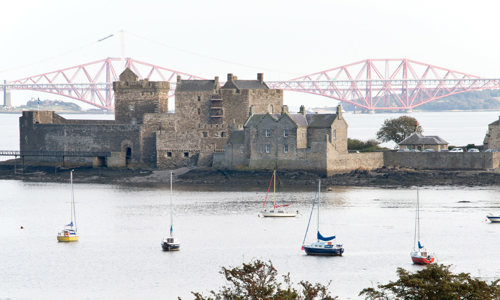
Find out more
Blackness castle.
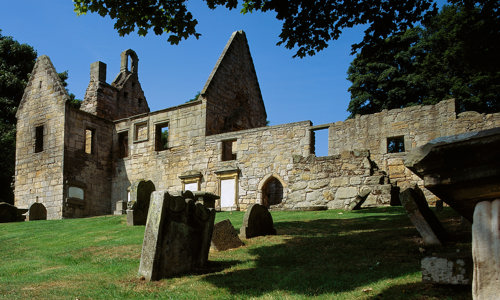
St Bridget's Kirk
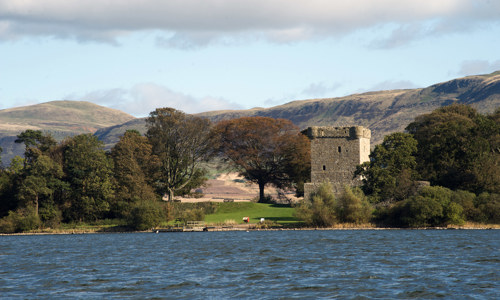
Lochleven Castle
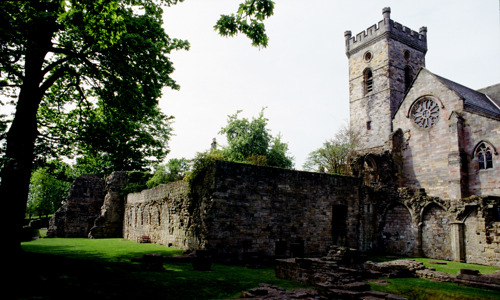
Culross Abbey
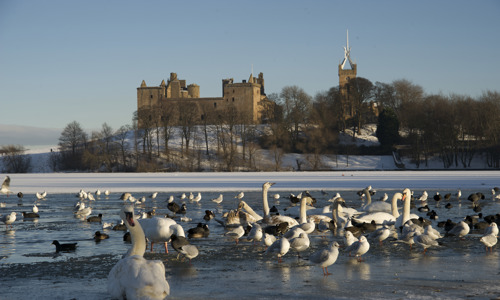
Linlithgow Palace
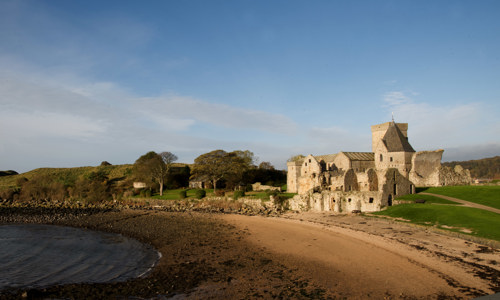
Inchcolm Abbey
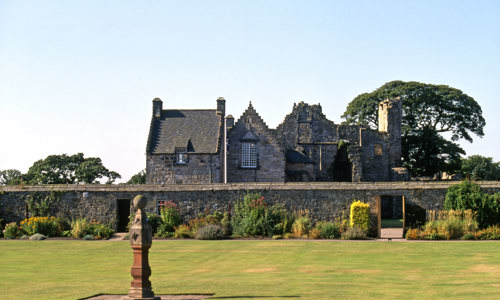
Aberdour Castle and Gardens
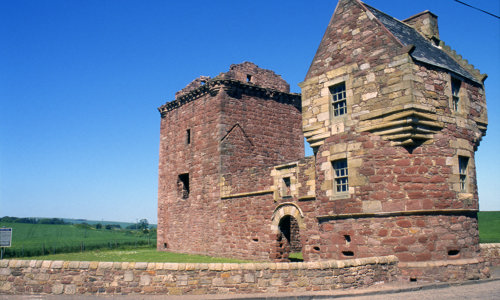
Burleigh Castle
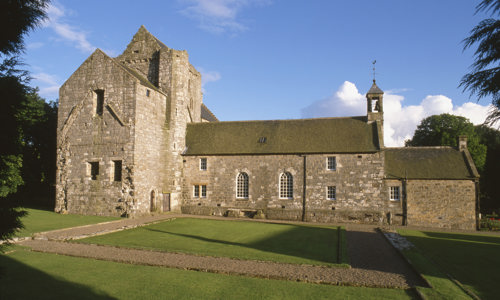
Torphichen Preceptory
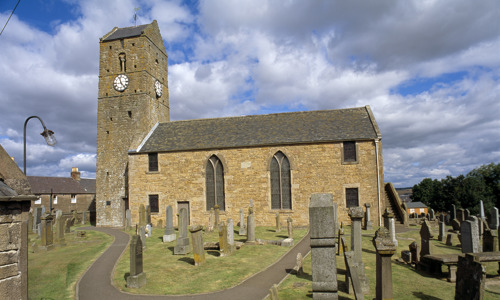
St Serf's Church and Dupplin Cross
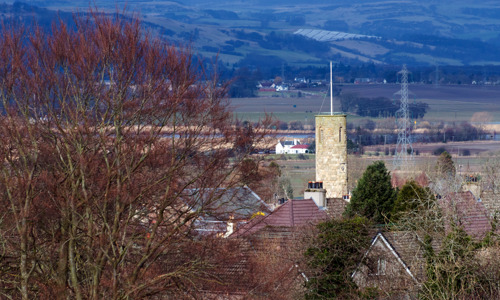
Abernethy Round Tower
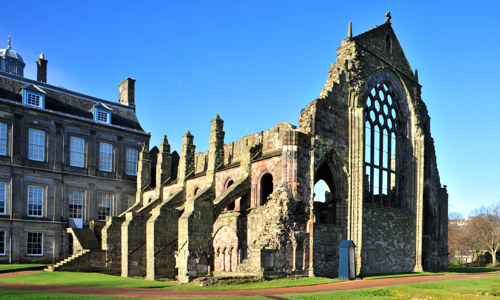
Holyrood Abbey
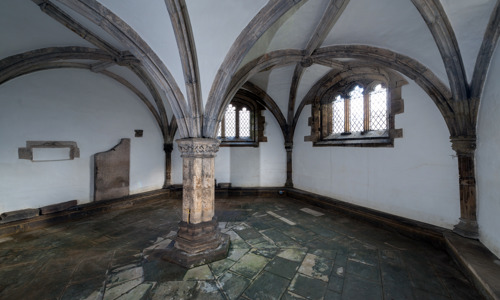
St Triduana's Chapel, Restalrig Collegiate Church
Download our visitor app.
Discover more on the go – the Historic Scotland app lets you find out about Scotland’s most iconic places wherever you are.
Plan your visit
More than 20 of our sites are now open. Please book your tickets in advance.
Become a member
Join Historic Scotland to visit our properties free of charge for a full year and support our work at the same time.
Hire a site for filming
Use one of our fantastic locations on your next shoot for an awe-inspiring backdrop to your work.
Learning visits
Our 300+ historic places serve as creative inspiration for all sorts of learning activities – and for learners of all ages.
Search our events
See the past brought to life by the imaginative year-round programme of events at our properties.

COMMENTS
Dunfermline's bid for city status was based on its heritage and its historic status as an ancient seat of royal power but it is also one of the fastest growing towns in Europe. Dunfermline was established as the new seat of power in 1057 by King Malcolm III, who married Margaret of Wessex. It was Margaret of Wessex who brought the Benedictine ...
The King and his Queen Consort will visit Dunfermline next week in their first joint public engagements since the period of royal mourning ended. Charles and Camilla will attend an official ...
Royal Visit HRH Princess Margaret. Royal Visit of Princess Anne. Spirit in the Stones. ... and on Malcolm III making his home and the Church in Dunfermline in the east, The 'Royal Sepulture for Scotland' where he and his Queen and Saint Margaret IN 1093 along with at least twenty one of Scotland's Royals from his time, continued to be buried in ...
3 October 2022. King Charles and Queen Consort greet crowds on visit to Dunfermline. Large crowds gathered in Dunfermline to welcome King Charles and the Queen Consort on a visit to mark the ...
It's the final resting place of King Robert the Bruce along with seven other Scottish kings and queens and is a fascinating visit. Discover the remains of the refectory, dormitory range, latrines, gatehouse, kitchen and royal palace. Dunfermline Abbey, St Margaret's Street, Dunfermline, KY12 7PE. Visit Website View Location.
The Royal visitors will pay a visit to Dunfermline City Chambers, where King Charles will confer City status on Dunfermline as part of The Queen's Platinum Jubilee celebrations. Following the ceremony in the City Chambers, Their Majesties will take a short walk to Dunfermline Abbey, which is celebrating its 950th anniversary, where they will ...
DUNFERMLINE ABBEY will welcome a royal visitor today (Wednesday) to mark its 950th anniversary. The Princess Royal is to visit the city landmark for the event, with more than 300 representatives from the community, churches, ecumenical partners, and heritage organisations also invited to attend. A new piece of music was even commissioned for ...
Dunfermline visit marks first official royal engagement since period of mourning. Fife Provost Jim Leishman - who welcomed the royal couple to Dunfermline - said the visit was a great honour ...
Plan your visit. More than 20 of our sites are now open. Please book your tickets in advance. Become a member. Join Historic Scotland to visit our properties free of charge for a full year and support our work at the same time. Hire a site for filming. Use one of our fantastic locations on your next shoot for an awe-inspiring backdrop to your work.
Visitors are reminded that they may have a wait to see the Royal couple and to wrap up against the autumn chill. Toilet and baby changing facilities are available at Dunfermline Bus Station, in the main building opposite the door to Stances 1 - 3. Provost of Fife, Cllr Jim Leishman said the visit is a "great honour" for Dunfermline and Fife.
Dunfermline. KY12 7PE. Scotland. Tel: +44 (0)1383 723005. Email us at [email protected]. The tomb of King Robert the Bruce and many other royal and historical associations attracts tens of thousands of visitors each year. Many more join us for worship at our Sunday services, or midweek prayers.
Visit Us. Dunfermline Abbey sits at the heart of Dunfermline, Scotland's ancient capital. Dunfermline lies thirty minutes from the centre of Edinburgh, across the spectacular Queensferry Crossing. Dunfermline`s royal and monastic past dominates a town whose lifeblood is history. Dunfermline Abbey is the final resting place of King Robert the ...
Plan your visit. More than 20 of our sites are now open. Please book your tickets in advance. Become a member. Join Historic Scotland to visit our properties free of charge for a full year and support our work at the same time. Hire a site for filming. Use one of our fantastic locations on your next shoot for an awe-inspiring backdrop to your work.
Some of Scotland's greatest medieval monarchs were laid to rest at Dunfermline Abbey. Founded as a priory, Dunfermline was made an abbey by David I and later became a royal mausoleum. Following the Protestant Reformation of 1560, Queen Anna of Denmark created an imposing palace with the monastic guesthouse at its heart.
Charles visit is recognition of Dunfermline's royal ties. In the wake of Elizabeth II's death at Balmoral, there is a synchronicity to the choice of Scotland's ancient capital for King Charles ...
Founded as a priory, Dunfermline was made an abbey by David I and later became a royal mausoleum. Following the Protestant Reformation of 1560, Queen Anna of Denmark created an imposing palace with the monastic guesthouse at its heart. Charles I was delivered here in 1600 - the last monarch to be born in Scotland.
Dunfermline Palace and Abbey are the remains of a great Benedictine abbey founded by Queen Margaret in the 11th century. Dunfermline Palace and Refectory are currently closed, but the abbey nave and shop are open. Admire one of Scotland's most impressive medieval interiors and most important royal sites. Dunfermline Abbey and Palace was ...
The Highlights. 1: Dunfermline Abbey holds immense historical significance as the resting place of many Scottish monarchs, including Robert the Bruce. Visitors can explore the majestic royal tombs and gain insights into the lives and legacies of these influential figures. 2: The abbey's architecture is a sight to behold. From the intricate stone carvings to the soaring Gothic arches, every ...
Clan Mackenzie Routes specialise in walking tours for all those who love history. Choose from two of the tours on offer. Visit fantastic historic attractions including Abbot House and Dunfermline Abbey on the 90-minute Royal Heritage and History Tour, or take a whistle stop tour of the life and legacy of Dunfermline's very own Andrew Carnegie.
It was re-buried below the pulpit of the new church, and the 200th anniversary of the reinternment of Bruce's remains was marked in 2019. "Dunfermline is hugely important in the national story as a royal burial place," says Judith Anderson, of the Cultural Resource Team at HES. "The tombs, which lie under the present-day abbey church ...
Dunfermline Palace became the personal residence of James VI's queen, Anna of Denmark. The future Charles I was born here in 1600, the last monarch to be born in Scotland. Royal interest in Dunfermline waned when James and Anna left for London in 1603, and the palace fell into disrepair. Read about the history of Dunfermline Abbey, where ...
Dunfermline became a royal residence and a favored location of several Scottish monarchs, including King Robert the Bruce, who is buried at Dunfermline Abbey. The town served as a royal burgh and was a hub of medieval Scottish culture. Industrial Revolution. During the 18th and 19th centuries, Dunfermline experienced significant industrial ...